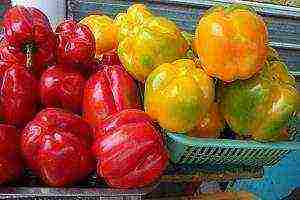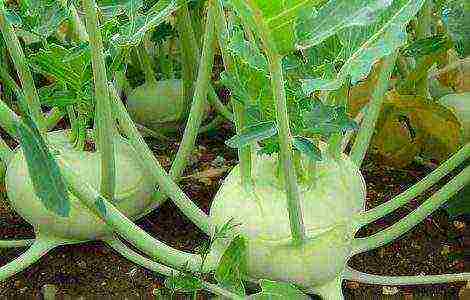Content
- 1 Summer pear varieties
- 2 Winter
- 3 Late
- 4 Autumn
- 5 Pear for the Volga region and central Russia
- 6 Garden varieties for the Moscow region, description
- 7 Basic requirements for pear varieties for Central Russia
- 8 Early (summer) varieties
- 9 Autumn varieties
- 10 Winter (late) varieties
- 11 The sweetest varieties
- 11.1 Prominent
- 11.2 Buttery sweet
- 11.3 Autumn sweet
- 11.4 1. Pear "Prominent"
- 11.5 2. Pear "Bryansk beauty"
- 11.6 3. Pear "The same age"
- 11.7 4. Pear "Banana"
- 11.8 5. Pear "Skorospelka from Michurinsk"
- 11.9 6. Pear "Veles"
- 11.10 7. Pear "Thumbelina"
- 11.11 8. Pear "Just Maria"
- 11.12 9. Pear "Irista"
- 11.13 10. Pear "Yeseninskaya"
- 11.14 11. Pear "Belarusian late"
- 11.15 12. Pear "Yuryevskaya"
- 11.16 13. Pear "Novella"
- 11.17 14. Pear "Otradnenskaya"
- 11.18 15. Pear "Extravaganza"
As you know, pear varieties are subdivided into winter, autumn and summer varieties. Each category differs not only in terms of ripening, taste, but also in terms of storage of fruits... So, which varieties can be attributed to winter, and which ripen in summer, see the description below.
Summer pear varieties
August dew
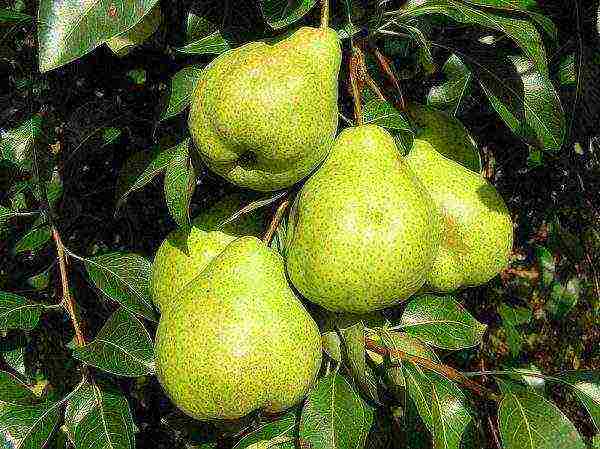 Pear August dew
Pear August dew
The undisputed favorite among summer pear varieties is August Dew, the result of a crossing of Tenderness and Triumph Pakgam varieties. The tree is rather low, less than 10 m in height, the bark is gray, smooth, the buds quickly "wake up" after winter. Branches are spreading, slightly drooping, curved. The leaves are oblong, medium in size, dark green in color. Fruits are of medium size, ripen in mid-summer. The taste is quite sweet, juicy, with white pulp and delicate skin.
Unfortunately, it is not suitable for long-term storage, the pear quickly turns brown and disappears. It is itself resistant to diseases and pests, easily tolerates winters, bears fruit every year, increasing the number of fruits. The disadvantage of this variety is that it constantly needs to trim the crown, because of this, the fruits become smaller.
Bere Giffard
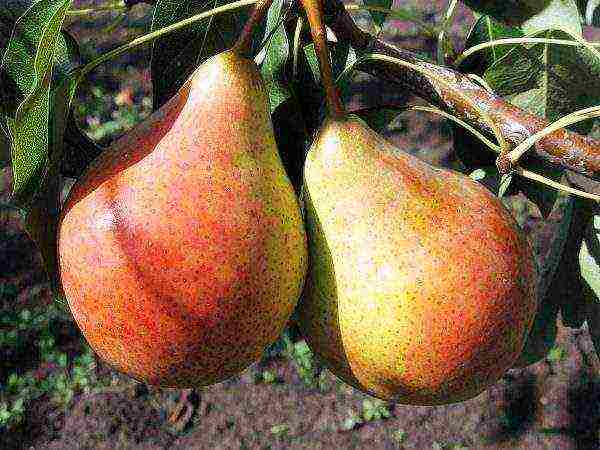 Pear variety Bere Giffard
Pear variety Bere Giffard
The same applies to summer varieties of pears. They differ from other varieties with their "ruddy" fruits, red-orange tones on one side of the pear, and light green shades on the other side. Formed on a branch in bundles, from 2 to 6 pieces, and keep so until fully ripe. Due to the high yield, additional supports are often required, otherwise the branches may break under the weight of the fruit.
The fruits are tender, have a sweet taste, juicy, with white flesh. The tree reaches more than 10 m in height, a sparse crown, branches are slightly drooping and thin. The crown is brown, peels off. The leaf plate is dark green, oblong, with smooth edges. The variety does not tolerate severe winters, therefore, young seedlings require shelter. Fruits are poorly preserved when plucked, no more than a week.
Victoria
 Winter-hardy pear variety Victoria
Winter-hardy pear variety Victoria
This variety is distinguished by its winter hardiness, is not afraid of drought and is rarely exposed to diseases and pests. It appeared as a result of crossing the varieties Bere Bosk and Tolstobezhka. Medium tree, 8-10 m, with a dense crown, has a pyramidal trunk shape, branches are long and thin. The variety is characterized by late vegetation, flowering. Productivity is high, more than 150 kg of harvest is harvested from an adult tree per year.
The pear begins to ripen in the second half of August, reaching its peak of maturity only by the middle of September. The fruits have a regular pear-shaped shape, with a smooth and thin skin.... The pear tastes sweet, with juicy pulp, has a pleasant aroma. It is good to make jam and jams from this variety. But the pear is stored for a short time, in a torn form it does not deteriorate for about 3 days, it can hang on the tree for no more than a week, then it falls off.
Victoria is only half pollinated. To increase yields, it is recommended to plant it next to varieties such as Bere Dumont,
Williams
Red.
Duchess
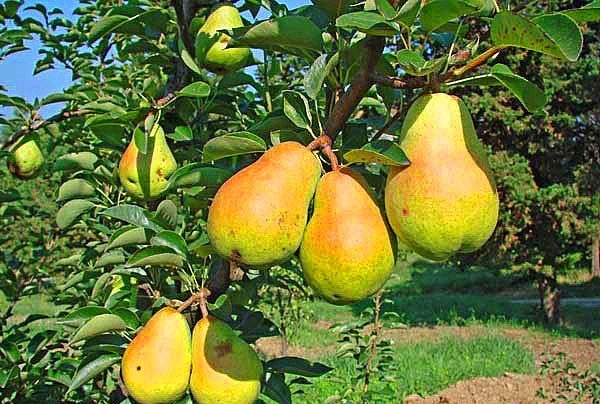 Summer pear variety Duchess
Summer pear variety Duchess
The name of the variety, translated as Duchess, was bred by an English breeder in Wheeler. The tree is not tall, 6-7 m, with a dense crown, branches are spreading, thin... The crown is a light brown tree, smooth.
Fruits begin to ripen in mid-August, the fruits are bright yellow. On average, one pear can weigh more than 150 g, are located on the branches singly or in groups of 4-6 pears. Stored up to 40 days on a tree and no more than 2 weeks when torn off... The fruit tastes juicy, sweet, with a thin skin and delicate aroma. The taste contains light notes of nutmeg and spices. The variety is frost-hardy, not afraid of cold weather. It is also not affected by scab, but copperhead and aphids are found on the tree very often.
How can you tell if summer pears can be picked from the tree? Firstly, if fallen fruits have already begun to appear on the ground, then the harvest is ready. Secondly, it can be determined by the color of the fruit, the ripe fruits become yellowish. Thirdly, if the pear has become soft to the touch, then it can be safely removed from the tree.
Severyanka
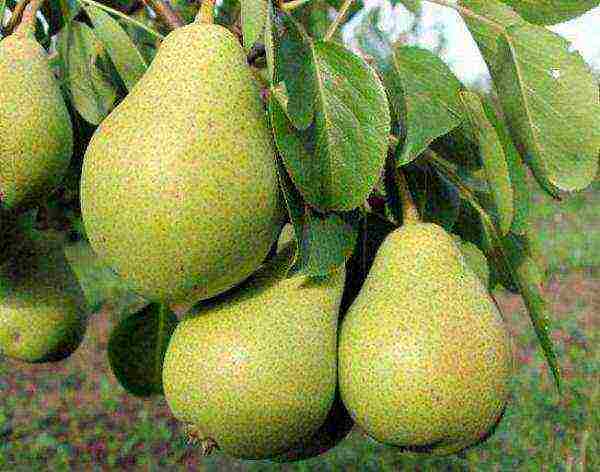 Pear variety Severyanka
Pear variety Severyanka
It was bred by breeders for the northern regions, hence its name. The variety is medium-sized, tree height from 3 to 6 m, with a dense crown and a pyramidal trunk shape... Young seedlings easily tolerate planting and quickly begin their growth, but the tree begins to bear fruit in 4-5 years. The leaves of the tree are light green, pointed in shape, with smooth edges. It blooms in early spring, has more than 6 petals in the inflorescence /
A variety with a high yield, the fruits are strewn with branches, every year the harvest becomes larger, in the same way, the tree bears fruit every year. The pear is large, up to 200 grams each fruit, they are formed into small clusters of 4-6 pears... At the beginning of ripening, they have green tones, and then they acquire yellowish-orange shades. The skin of the fruit is loose, sometimes rather rough. The taste is not inferior to other varieties, sweet, with juicy pulp, has a sour-tart taste and light aroma. But there are not many seeds in the pear, they are located in special chambers in the heart of the fruit. It tolerates winters, diseases and pests well enough, does not need special care.
Cathedral
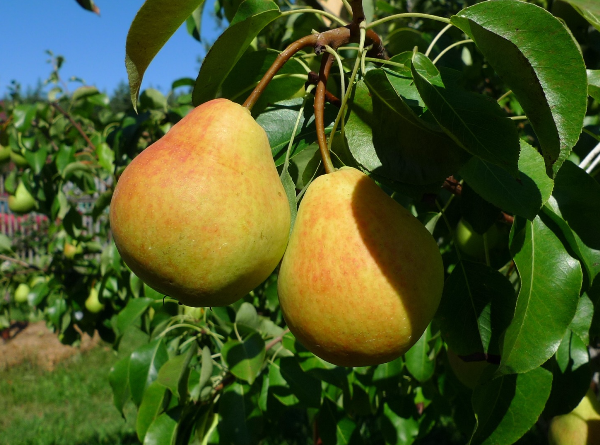 Rapid pear variety Cathedral
Rapid pear variety Cathedral
The same applies to summer, early-growing varieties. It was bred by crossing Lesnaya Krasavitsa and Duchess Bedro varieties. It grows mainly in the Central regions, but due to its resistance to frost, it grows easily in the regions of the North. The tree is medium-sized, from 4 m in height and above, with a wide and dense crown, the branches look up... The trunk is smooth, brown-gray. Young shoots are slightly drooping, reddish-brown in color, fruiting occurs on them. Leaves are green, smooth, medium in size.
Fruiting begins from the 6th year, the weight of a pear can exceed 130 grams.Ripening occurs in mid-August, the fruits remain on the tree for no more than 2 weeks, even less when plucked. Lemon-colored fruit with many splashes, change their shades closer from autumn to red-orange, which indicates full ripening of the fruit. The skin is thin, the flesh is creamy or white, sweet with a pleasant aroma, medium density. In the middle of the fruit are brown seeds, elongated.
Summer varieties of pears ripen by mid-summer, it is important to remember about their proper care. Summer pears love moisture in spring and especially during fruit formation. For the harvest to be faster, the tree needs annual pruning and feeding.
Winter
Saratovka
Obtained as a result of crossing the varieties Bere and Bergamot... They worked on a new variety at the Saratov State Agrarian University named after V.I. Vavilov. Refers to winter, plucked fruits under the right conditions can be stored until February!
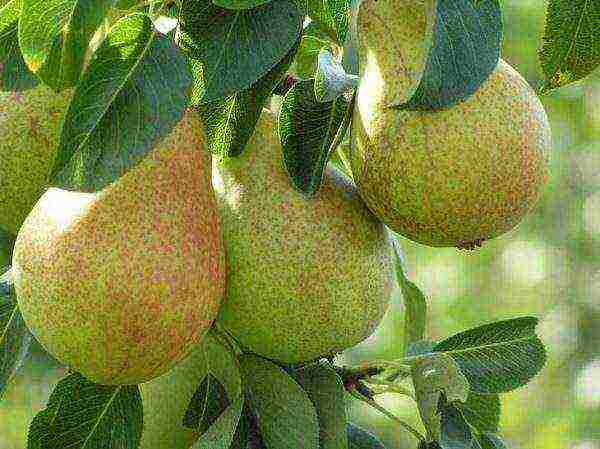 Frost-resistant pear variety Saratovka
Frost-resistant pear variety Saratovka
Saratovka is a medium-sized variety, the branches look straight up, the tree is more than 10 m high... The crown is dense, the trunk is brown-gray. Young leaves of light green color, oval, with smooth edges. By the fall, they are painted in dark green tones. The disadvantage is the dense crown, which needs proper pruning every year, otherwise, the tree reduces the amount of harvest, more energy is given to the formation of young shoots.
The yield is high, but the tree begins to bear fruit only in the 5th year. The fruits are sweet, firm, with a thick skin, lemon color, with a red-orange blush. It begins to ripen from mid-August, remains on the tree for a long time, until the end of September. The variety is winter-hardy, rarely exposed to diseases and pests, also tolerates long-term transportation, does not lose taste and external qualities.
Kondratyevka
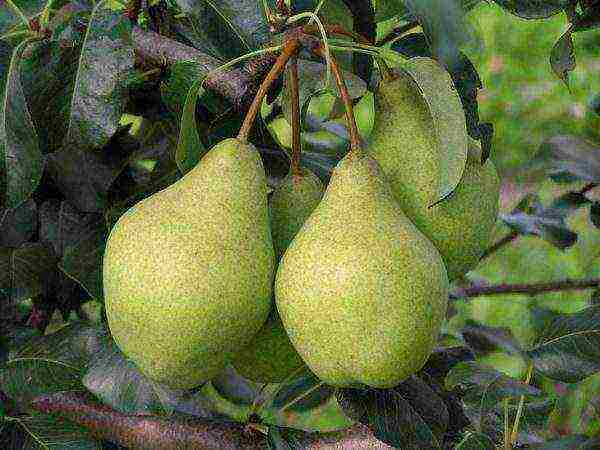 High-yielding pear variety Kondratyevka
High-yielding pear variety Kondratyevka
Winter pear variety, ripening occurs in early and mid-September. High yields start from 5 years after planting. Gives a bountiful harvest annually, the tree does not need rest. The mass of one pear reaches up to 230 grams... The fruits are sweet, juicy, with delicate pulp and spicy aroma. They have the correct pear-shaped shape and are attached to a thick curved stalk. They are green when ripe, slightly yellowish.
The tree itself is quite tall, 10-12 m in height, with a pyramidal trunk and slightly drooping branches. The variety differs from others in its slow growth, it mainly builds up green mass. But then it bears a large number of fruits. Survives severe cold quite easily, tolerant of various diseases and pests.
Pass-Krasan
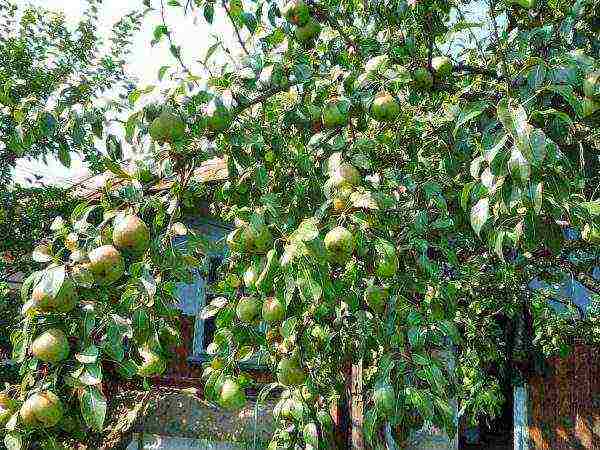 Pass-Krasan pear requires a lot of sunlight
Pass-Krasan pear requires a lot of sunlight
The same applies to winter pear varieties. Unlike other varieties that do not need special conditions, this hybrid requires increased attention. It prefers to grow only in sunny places, does not tolerate close proximity to other seedlings. From a lack of sunlight, its fruits become sour and do not reach the required size... He also loves moisture and well-fertilized soil. It is extremely cold and susceptible to many diseases.
But subject to all conditions, it gives large, juicy fruits with a slight sour taste. It bears fruit annually, does not require rest, but you should not expect a large amount of harvest from this variety. The mass of one pear can reach more than 200 grams, large pears are light green in color. The right time to harvest is mid to late October, by this time the fruits reach their optimal size and retain their taste. The advantage is the ability of the fruit to last until next spring.
In order for the variety to begin bearing fruit earlier, it is better to graft young seedlings on quince.
May Day
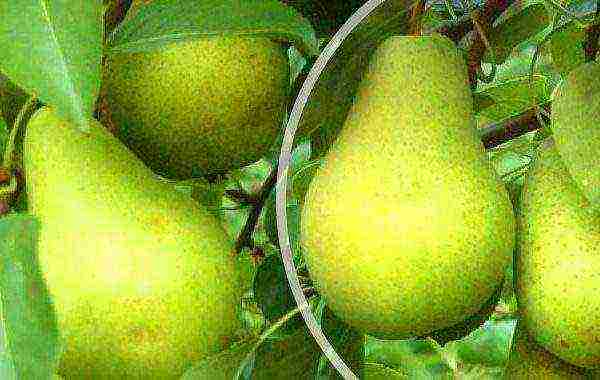 The fruits of the Pervomayskaya variety can last up to 8 months.
The fruits of the Pervomayskaya variety can last up to 8 months.
The result of crossing pears Daughter of Dawn and Late.This variety differs from others in the storage duration of the plucked fruits, up to 250 days! The pear is not demanding to care for, it is frost-resistant. She rarely gets sick, she doesn't care about many pests. The height of the tree is more than 10 m, with a spreading crown... Young shoots are rather thin, gray-brown, smooth. The leaves are round in shape, with smooth edges, slightly curved upwards.
Average fruit weight from 140 grams, have the correct shape, smooth and thin skin. During the summer, the fruits are green, towards autumn they acquire brown-red tones. Attached to branches with a strong stalk, forming a cluster of 4-6 fruits. Sweet to taste, with a pleasant aroma, slightly tart, with white pulp, has an attractive appearance and taste. The variety has a high yield, but fruiting begins at 5-6 years.
Lyre
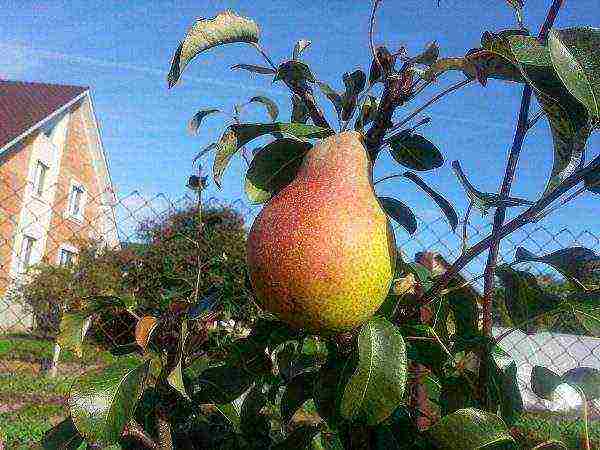 Pear Lear
Pear Lear
Winter variety, with a high storage capacity of fruits, up to several months. A tree with a wide pyramidal trunk, light brown in color. Branches of medium thickness, most often gray, smooth. The leaves are elongated, smooth, of dark green shades.
Pear weight more than 200 grams, fruits of greenish tones, acquire a yellowish tint. They have an elongated fruit shape, with a smooth and thin skin. Harvesting can begin from September. The pear is sweet to taste, with white juicy pulp. The yield is high, the tree does not need interruptions, but the harvest begins to appear only 4-5 years after planting. Resistant to diseases and pests, but has an average winter hardiness. Especially young seedlings need additional shelter for the winter.
Patriotic
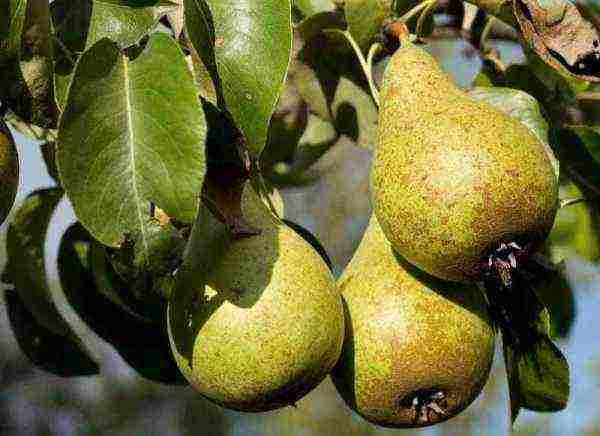 Winter variety of pears Patriotic
Winter variety of pears Patriotic
The result of the joint work of O.S. Kharchenko, A.V. Krasovsky and A.F. Mileshko. Blooms in late spring, white rounded flowers with a light aroma. The tree itself is tall, more than 10 m, with a spreading crown, straight branches. The trunk is brown, smooth, regular in shape.
Fruits are large, light green in color, more yellow when fully ripe. Fruit weight up to 180 grams, has an attractive view for sale, also protects the view during long-term transportation. It is recommended to harvest the tree in early October, the fruits can be stored for several months in a cool place. It produces crops regularly, the tree rarely gets sick and is almost not damaged by insects. It is also frost-resistant and does not need special care, it tolerates scab and thermal burns of leaves. Ripe fruits are stored for several months.
For pears to be stored longer, it is important for them to provide the necessary conditions. The fruit must not be damaged or dented when harvested. Also, the pear should be dry and wrapped in newspaper or paper. It is better to store in small boxes, in 2-3 rows. The room should not be damp, too hot and humid. The optimum storage temperature is + 8-14 degrees, in a dark place.
Late
Dessert Rossoshanskaya late
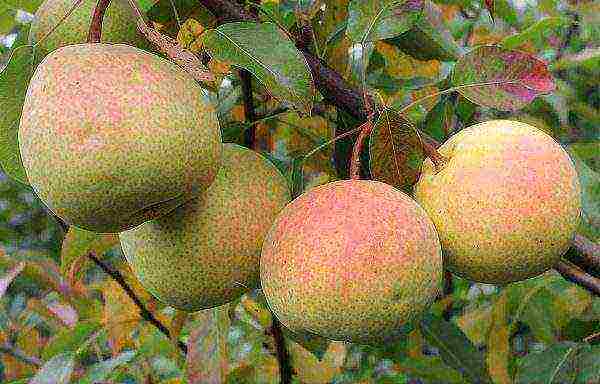 Rossoshanskaya - pear with fruits of the autumn ripening period
Rossoshanskaya - pear with fruits of the autumn ripening period
Belongs to late varieties, ripening of fruits comes at the beginning of September. The dessert pear can be stored until January under the correct storage conditions.... A hybrid, the result of crossing the varieties Lyubimitsa Klappa and Tonkovotka, bred in 1952. The tree is vigorous, more than 6 m in height, the seedling has a narrow pyramidal trunk, gray in color, an adult tree forms a wide and smooth trunk. The crown of the pear is branched, young branches are gray, looking up.
The fruit is large enough, weighing up to 180 grams, dark green tones at the beginning of ripening and brown-red shades by autumn. Fastened on branches of 6 pieces on thick stalks. Harvesting begins at 3 - 4 years, the yield percentage is high. Sweet to taste, with soft skin and juicy pulp.
Belarusian
 Pear Belorussian late
Pear Belorussian late
Bred in Belarus. The variety is late, ripening at the beginning of September. Small tree, no more than 3.5 m in height, branches look straight up, the crown is gray-brown, smooth. Leaves are light green in color, oblong in shape, with uneven edges. Flowering occurs at the beginning of spring, the inflorescences are white, with a pleasant aroma.
Fruits are dull, light green in color, changing to orange-red shades during the summer. The peel of the pear is rough, rather dense, with small black spots. The stalks are short, the pear is squeezed onto the branches in pairs. The pear tastes fleshy, with white flesh, juicy, has a slight sourness... The pear is winter-hardy, not subject to pests and diseases. Minus - it does not bear fruit every year, it needs rest.
Variety
Belarusian
is not always capable of pollinating on its own, therefore, in order to have a successful harvest, it is recommended to plant additional pollinated varieties on the site, for example,
Conference
or Bere loshitskaya.
Olivier de Serre
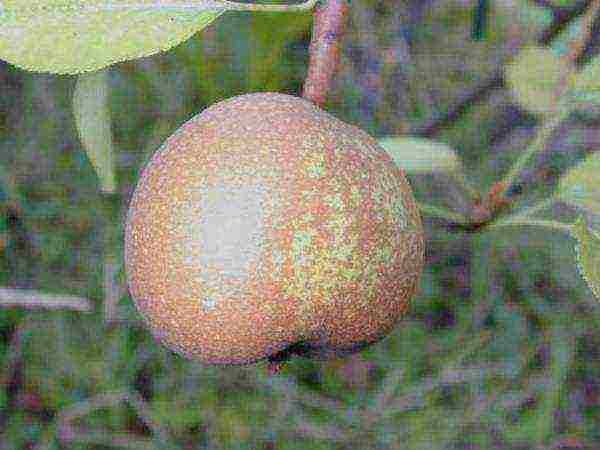 Olivier de Serre
Olivier de Serre
The work of a French breeder. The variety is quite capricious, requires special conditions for growth and careful care. The tree is medium-sized, the crown is compact, the branches are directed upwards. Crown of brownish shades, smooth, slightly flaky... During the summer, it forms many new branches, which reduces the yield, so it is important to remove excess branches in the fall. The leaves are shiny, dark green, rounded.
Fruits can weigh more than 400 grams... In appearance, the fruits are small, round in shape, with a thick skin. The whole fruit is covered with red spots, the surface is bumpy, uneven. The pear is sweet, with white fleshy pulp and a light pleasant aroma. The pear ripens by September and is stored harvested until spring. It is resistant to diseases, but in severe winters it needs additional shelter, otherwise the amount of harvest in the next year decreases.
Bere Ardanpon
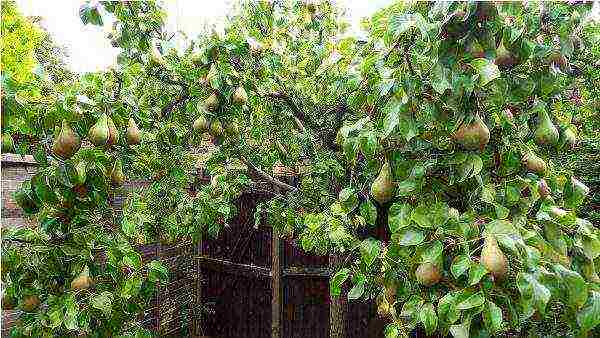 Pear of late ripening Bere Ardanpon
Pear of late ripening Bere Ardanpon
It was bred in Belgium by N. Ardanpon in 1759. This winter-hardy undersized hybrid requires special care. It prefers to grow in the sun, heat and well-moisturized soil - only under these conditions does the tree bear fruit. The tree is vigorous, with a dense crown of brownish-gray color... Young branches are thin, not lowered, The leaf blade is pointed, dark green, slightly pointed in shape. Blooms in early spring, with white fragrant inflorescences.
The fruits are large, green in mid-summer and reddish when fully ripe closer to autumn. A pear with a thin, smooth skin. This variety fell in love with gardeners because of its attractive presentation., which persists until cold weather. The pear is sweet to taste, with white, fleshy flesh. It tolerates winter firmly, but it is better to cover young seedlings.
Hera
 The Gera variety is famous for its large fruits.
The Gera variety is famous for its large fruits.
The same applies to winter varieties, which appeared as a result of crossing Reale Turin and Daughter of the Dawn. The variety is not particularly different from others, but because of its large fruits, it fell in love with gardeners. One pear can weigh up to 280 grams! In addition, the fruits have light green hues, which change to reddish during the ripening process. Not inferior in taste, pears are sweet, with fine-grained cream-colored pulp. They have a delicate, slightly sour taste, with a pleasant aroma.
The tree is medium-sized, no more than 6 m high, with spreading branches, crown, brownish color. Capable of producing a large amount of harvest annually, not picky about conditions and care. Plucked fruits can be stored for several months. In addition, the variety is quite resistant to diseases, is not afraid of insects, and is frost-resistant.
In ancient Greece, pear fruits were used as a remedy for nausea.
Miracle woman
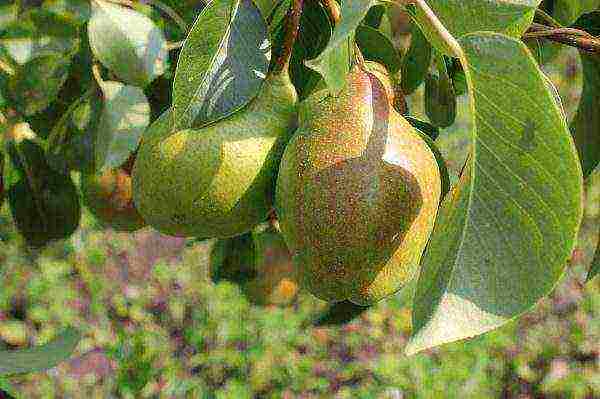 Pear Miracle
Pear Miracle
Another winter pear, a hybrid obtained by crossing the Daughter of Zarya and Talgar beauty varieties. Possesses excellent resistance to frost and disease... It has a pyramidal crown shape, no more than 5 m high. The branches are thin, look up, gray-brown in color.The leaves are rounded, dark green in color, small light streaks are clearly visible. Blooms in early spring, white fragrant inflorescences.
High yield variety, by weight one fruit from 140 to 210 grams, can remain on the tree for a long time and can be stored for a long time when assembled. Fruits are light green in color; towards autumn they become yellowish, slightly elongated. Sweet to taste, with fleshy pulp, have a delicate pleasant aroma.
Autumn
Autumn garden varieties differ from others in their long storage time in assembled form, they are not inferior in taste to summer or winter ones.
Veles
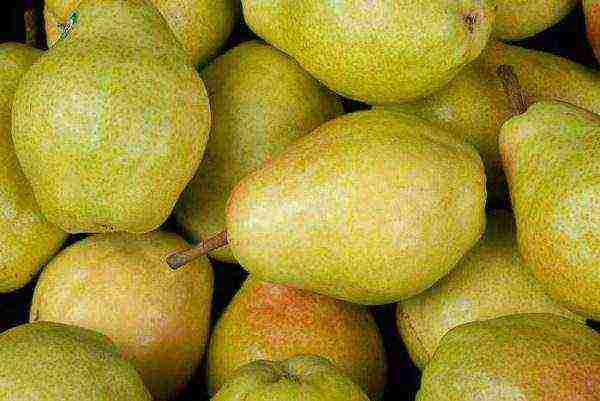 Veles pear variety
Veles pear variety
Autumn pear variety, one of the best. Fruits are large enough, the average weight of a pear is from 150 grams and above... Fruits are regular pear-shaped: narrow at the stalk and rounded at the bottom. On the branches they grow in small clusters, 3-4 pears each. The Veles pear ripens at the end of August, remains on the tree until October. It has a beautiful appearance, until the end of summer the fruits are dark green, and when ripe, they become red-orange tones. The taste is sweet, juicy, with fleshy pulp and thin skin.
The height of the tree is no more than 8 m, with drooping branches and a pyramidal shape of the trunk, gray-brown in color. Young branches are formed throughout the summer, which affects the amount of the harvest, it is recommended to prune in the fall. Resistant to frost, disease and pests.
Bere Moskovskaya
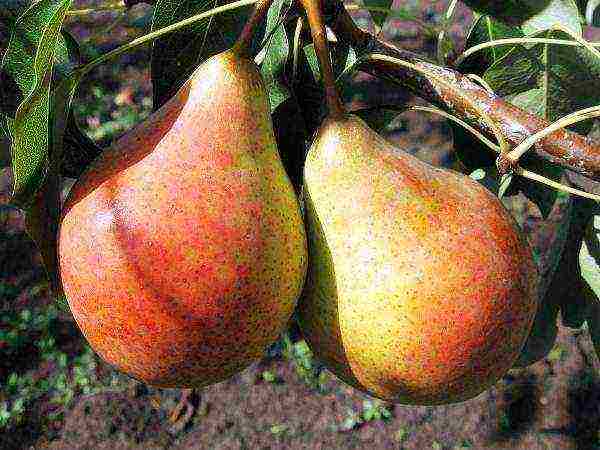 Bitter-tart pear variety Bere Moscowskaya
Bitter-tart pear variety Bere Moscowskaya
Frost-resistant, almost not exposed to diseases and pests. It appeared as a result of pollination of the Olga variety with pollen from the Lesnaya Krasavitsa and Lyubimitsa Klappa varieties. A tree no more than 6-8 m high... The crown of the pear is round, light brown in color. Young branches are rather thin, drooping, gray or brown in color. The leaf plate is dark green, rounded. The pear blooms in early spring.
Fruits are slightly bumpy, light green shades, there is a slight blush closer to autumn.It is best to remove fruits that are slightly green and firm in early autumn., so they keep better and stay longer, up to several months in a cool and dark place. If the pear tastes slightly tart, with sourness, it means that the pear lacks moisture. With proper care, the pear becomes sweet and fleshy, with a delicate white flesh. In general, this variety is not capricious when leaving.
Red-sided
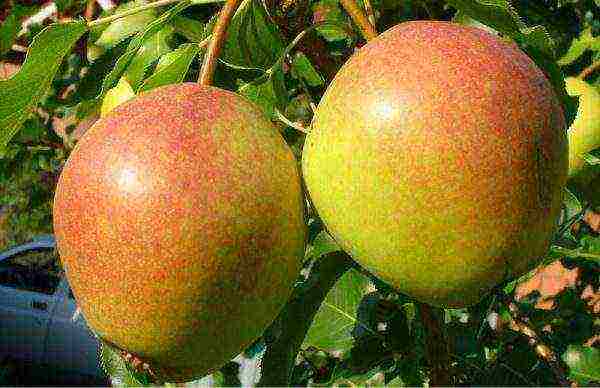 Pear variety Red-sided
Pear variety Red-sided
The misconception that this variety belongs to the winter, it is not, the variety is autumn ripening. It was obtained as a result of crossing the varieties Zheltoplodnaya and Tenderness. Resistant to diseases and pests, especially scab... It is frost-resistant, gives a good harvest from year to year. The crown is rounded, the branches are slightly drooping, brown-gray in color. Leaves are slightly pointed, light green shades in spring and dark green tones closer to autumn.
Does not require special care, can grow in small shade, under taller trees, but loves moisture. Fruits of medium size, weighing no more than 200 grams... Green pears change their shades to a raspberry blush as they ripen. Sweet to taste, with juicy fine-grained pulp and thin skin. Stick to branches, on short, curved stalks. The fruits are able to survive for a long time, both on the tree and in the assembled state, they are not afraid of transportation.
In memory of Yakovlev
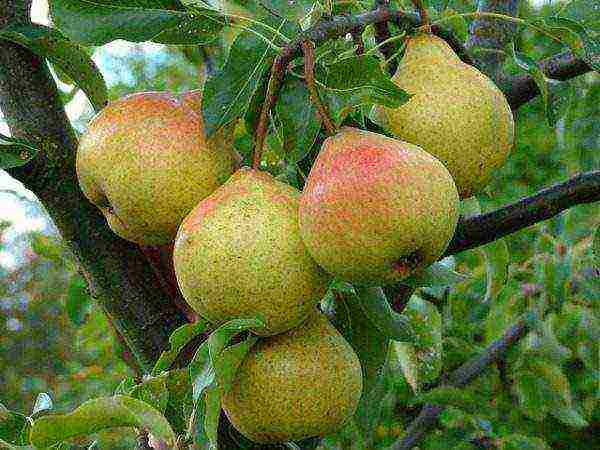 Pear variety of high winter hardiness in Memory of Yakovlev
Pear variety of high winter hardiness in Memory of Yakovlev
A medium-sized tree with a dense crown. The height of the tree does not exceed 1.5-2m, with a spherical crown. Young branches are thin, looking up, brown-gray in color with small thorns. The leaves are dark green, ovoid, with smooth edges. The harvest gives for 6-8 years... The Pamyati Yakovlev variety is popular among gardeners due to regular fruiting and unpretentious care.
Pears with smooth and thin skin, weighing no more than 200 grams. The fruits are collected in groups of 5-7 pears. The pear is sweet to taste, with juicy pulp and pleasant aroma.The fruits are golden in color, slightly reddish at the end of ripening. Full ripening of fruits occurs in mid-October.... The pear is stored on the tree for a long time, does not fall off, and in the assembled state it can lie for several months. High yield, which increases every year the tree grows. More than 30 kg of ripe pears are harvested from an adult tree per year. In addition, it is capable not only of self-pollination, but also pollinates other varieties of pears. It greatly simplifies the care of a pear that it is winter-hardy and unpretentious in care.
For the first time the word "pear" was mentioned in chronicles in the 12th century, and sounded like "hrusha". And all, because of the characteristic crunch, which was published when biting the fruit.
Muscovite
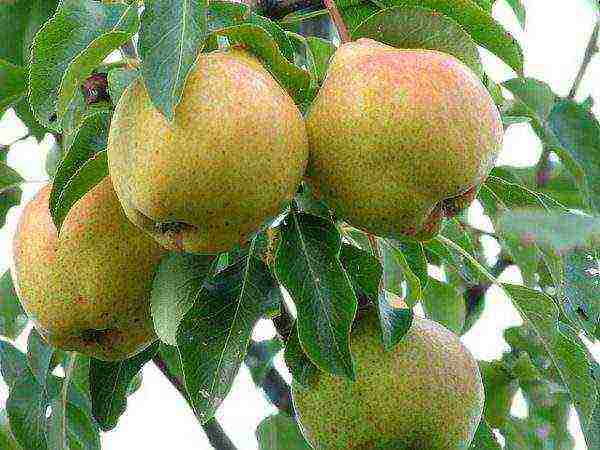 Branch of pear Moskvichka with fruits
Branch of pear Moskvichka with fruits
Obtained as a result of pollination of one of the American Kieffer pear varieties. Possesses a standard shape, with a rather dense and spreading crown, light gray colors, which eventually changes shades to brown tones. Forms new curved shoots quickly. The foliage is light green in color, with an oval shape, slightly curved in the center. This variety produces a bountiful harvest in the southwestern regions. The first harvest is formed in 3-4 years.
Fruits Moskvichki are medium in size, up to 150 grams. They have the correct pear-shaped shape. They have a greenish-yellow hue, which changes towards burgundy-crimson tones by the end of summer. The skin is thin, fleshy with a juicy pulp with a pronounced sweet-sour taste. It is recommended to pick pears when they are slightly underripe, because after lying in the room for a couple of days, the pear ripens and retains its taste. Under the right storage conditions, the fruits are able not to spoil for several months.... High resistance to scab and rot, also not afraid of frost.
Marble
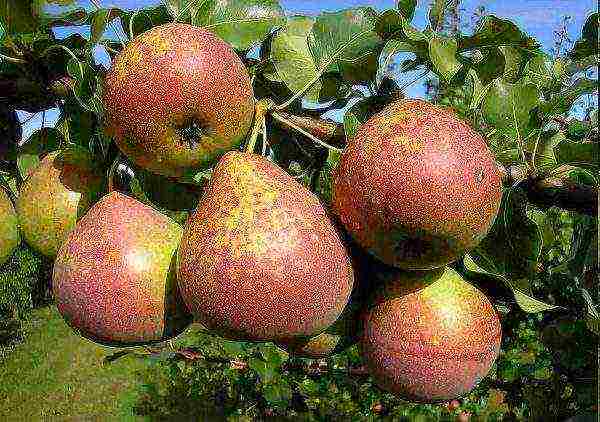 Marble pear fruits
Marble pear fruits
The fruit of the crossing of Bere Zimnaya Michurina and Lesnoy Krasavitsa varieties. The harvest of this variety ripens by the very beginning of autumn, the first fruits can be picked at the beginning of September. Differs from others in the height and density of the crown, the height of the tree is more than 8 m... Many light brown thin branches are formed every year, but pear shoots are extremely rare. Blooms in early spring with white fragrant inflorescences. The foliage is dark green in color.
The fruits are large, from 170 grams, with yellowish-green hues and a slight blush. The pear is also distinguished by the correct conical shape of the fruit. The pulp is coarse, tender, juicy. Rather dense rind, with small dots of a rusty color. The Marble variety, like other autumn pears, is frost-resistant, not afraid of diseases and pests. The tree begins to yield only 5 years, but the yield percentage is high, the pear is able to please with a large amount of harvest every year.
Pear for the Volga region and central Russia
Chizhovskaya
 Winter-hardy pear Chizhovskaya
Winter-hardy pear Chizhovskaya
Olga and Lesnaya Krasavitsa were taken as the "parental" varieties, as a result of the long work of S.T. Chizhov and S.P. Potapov and the Chizhovskaya variety was bred. One of the popular self-pollinated varieties in the middle lane, especially in the Volga region and surrounding areas... The tree is no more than 3 m high, the young tree has a narrow crown, grayish shades. Older branches acquire a brownish color, branches look up, medium in thickness, slightly curved. Leaves are oval, dark green in color with smooth edges.
By themselves, the fruits weighing no more than 150 grams. At the beginning of summer, the pear is of light green tones, the fruit is quite hard, but closer to autumn it acquires yellow shades and becomes soft. In this state, the Chizhovskaya pear will not hang on the tree for a long time, therefore it is recommended to pick it at the beginning of autumn. Green fruits can last for several weeks.... Sweet and fleshy on the palate, ripens in mid-August. They have a white, medium-grained pulp with a pleasant aroma. In addition, she inherited frost and disease resistance from her relatives.
The peculiarity of the variety is that the older the tree, the smaller the fruits.You can fight this with timely pruning.
Lada
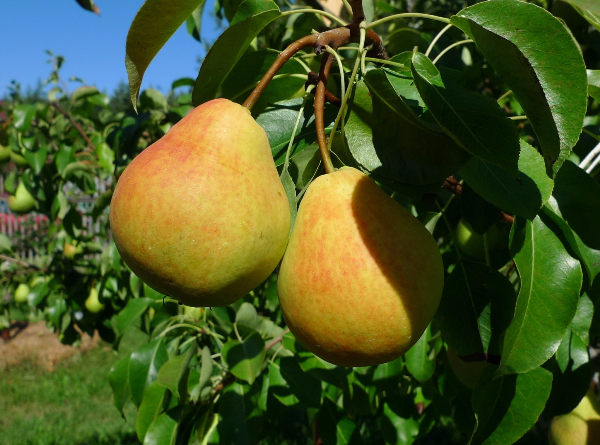 Pear Lada belongs to the early summer varieties
Pear Lada belongs to the early summer varieties
The result of crossing the varieties Lesnaya Krasavitsa and Olga, a variety suitable for planting in the middle lane. Differs in early maturity of fruits, you can taste fresh fruits already in the middle of summer... Lada is frost-resistant, is not susceptible to diseases and pests, and gives a rich harvest every year. A tree with a branchy crown, branches slightly drooping, looking down. The height of the tree is not more than 3 m, with a pyramidal trunk, closely gray in color. The leaves are shiny, smooth, dark green tones. It winters well enough even in the most severe winters, is resistant to diseases, partially self-fertile.
Medium-sized fruits, no more than 100 grams, light green tones with thin skin. Closer to ripening, the fruits give in yellow tones, become soft to the touch. It is important to take the moment to remove the fruits from the tree, otherwise they become soft, covered with rusty spots and fall off. The fruit is attached to the branches in pairs on short stalks. It tastes sweet, with a slight hint of sourness and can be stored for a long time when torn off, especially in a cool place.
Bessemyanka
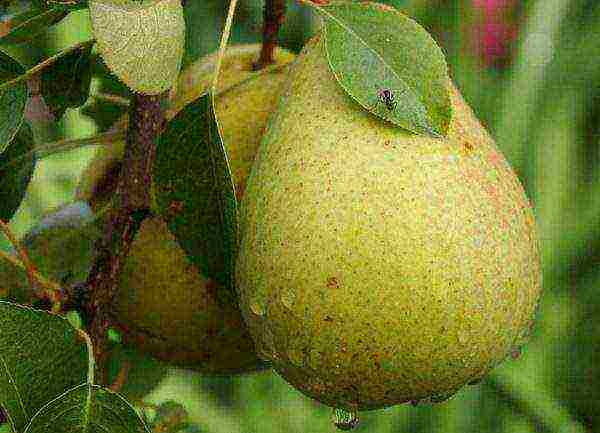 Pear Bessemyanka belongs to high-yielding varieties
Pear Bessemyanka belongs to high-yielding varieties
Popular and quite interesting for planting, especially spread in the Central regions, it also grows well in the middle lane. The tree is vigorous, the growth rate is fast, it yields consistently, does not need rest. The yield is high, more than 50 kg of fruits are harvested per year. The tree is more than 6 m high, with spreading and curved branches. The leaves are oval, dark green in color, with rounded edges. The variety is also resistant to frost, but prone to scab and other diseases.
Annually it pleases with a large amount of harvest, although the fruits are rather small, more like apples. Light green in color, firm when ripe, the fruits turn yellow and soft when ripe. Attached to branches, one fruit on short stalks. Ripening occurs at the end of summer, when the fruits become yellowish.... Does not last long on the tree, quickly falls off. In addition, it does not lie for long and in a torn form, no more than 2-3 weeks.
In Europe, until tobacco was introduced, crushed pear leaves were used for smoking.
Skorospelka from Michurinsk
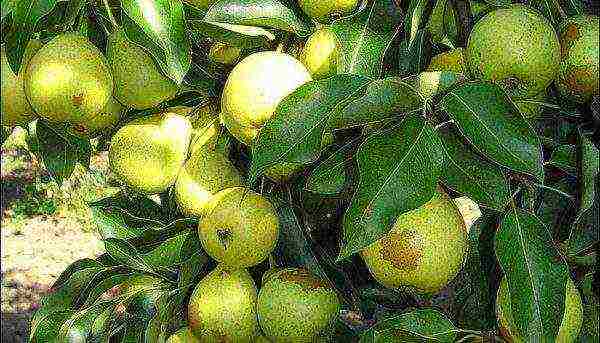 Pear Skorospelka from Michurinsk
Pear Skorospelka from Michurinsk
This variety breaks all records for the speed of fruit ripening. Bred by IV Michurin, as a result of crossing the varieties Citron de Carme and Bere Ligel. It belongs to the early varieties of pear, the harvest ripens by the middle of summer... It is a tall tree, the shape of the trunk is pyramidal, light brown in color.
Fruits no more than 90 grams, green in summer, acquire a yellow tint when fully ripe. Small fruits are offset by taste: sweet, juicy, this pear is loved not only by gardeners, but bees and birds. Therefore, it is better to collect them when they are a little hard, they are stored for no more than a week. The tree itself is winter-hardy, with a dense crown, resistant to diseases and pests.
Allegro
 Pear variety for the middle Allegro strip
Pear variety for the middle Allegro strip
Bred thanks to artificial pollination of the Osennyaya Yakovleva variety. Another variety for the middle lane, which bears fruit annually, is unpretentious in care, resistant to disease and severe cold. Fruiting begins at the age of 3 years, over time, the fruits become larger in size. Medium-sized tree, more than 5 m high, with a lowered crown. The branches are curved, light gray in color, the leaves are slightly elongated, closely green in color.
A pear weighing from 120 grams with a thick skin, but juicy and sweet pulp, with a spicy aroma. Correct pear-shaped, the fruits are slightly elongated. They are attached to the branches with a thick stalk, grow on a branch one by one. Ripening occurs at the beginning of August., the fruits turn yellowish-red and become soft. The variety is not stored for a long time, ripe fruits hang on the tree for no more than 2 weeks, but when assembled they can lie for more than a month.
The middle zone of Russia has a special climate that is not suitable for growing all varieties of pears. There are pronounced hot summers, severe winters, and transitional periods with a lot of precipitation. Only those who "love" this weather can grow and bear fruit here, and proper care will ensure a greater pear yield.
Garden varieties for the Moscow region, description
Prominent or Bumpy
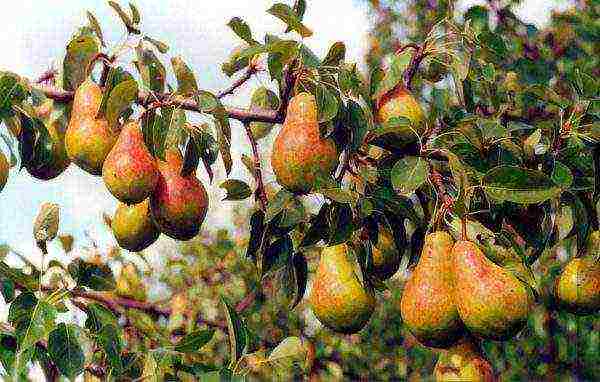 Pear variety Bumpy
Pear variety Bumpy
A pear variety that has long been loved by the Moscow region. A tree no more than 5 m high, with a fairly spreading young crown, which subsequently takes on a pyramidal shape. During the summer, the tree forms many young branches, which must be cut in the fall, otherwise the fruits will become smaller. The leaf plate is elongated, with light streaks, dark green in color. Blooms in early spring, many white inflorescences with a pleasant aroma.
Fruiting begins in the 5th year, fruits of medium size, regular pear-shaped. The color is greenish-yellow during the summer, with a red tint closer to autumn. Fruits with thick skin and coarse white flesh... Sweet and juicy on the palate, with a pleasant aroma. When harvested, they can last for several months, but it is recommended to harvest the fruits in mid-August, when the fruits are quite hard and slightly underripe.
Tenderness
 Hybrid variety Tenderness
Hybrid variety Tenderness
The variety obtained as a result of crossing Tyoma and Lyubimitsa Klapp. A particularly large amount of crops gives in the Volga region, the middle lane and in the Moscow region... The tree is medium-sized, no more than 4 m in height, with a sparse crown. The branches are thin, light gray. The tree blooms in mid-spring, white, small inflorescences. The leaves are round, with smooth edges, smooth. Frost-resistant, capable of bearing fruit annually. It prefers to grow in sunny areas, is resistant to diseases, is not afraid of pests, so growing this variety will not be difficult.
Fruits are large, weighing more than 200 grams with a regular pear-shaped fruit... The pear tastes soft, juicy, coarse-grained with a pleasant aroma. Attached to branches with short stalks. In the middle of the fruit is a chamber with brown seeds. The fruits of this pear are preserved for a long time both on the tree and in the harvested form, especially at a temperature of 0 degrees.
The pear tree is not capable of deforming, which is why, for example, rulers for architects are made from it.
Fabulous
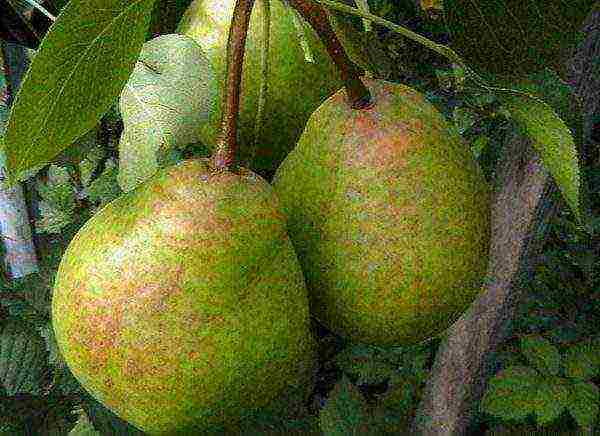 Pear Fairy is characterized as a tall and very productive variety.
Pear Fairy is characterized as a tall and very productive variety.
It got its name from the beautiful fruits. Obtained as a result of crossing the varieties Powislaya and Tenderness. The pear has a high yield, more than 30 kg of ripe fruits are harvested from one adult tree per season... The height of the tree reaches 4 m, the branches are dense, thin with a gray-brown crown. The leaf plate is smooth, rather small, of green shades, with small teeth along the edges.
When the pear ripens, it becomes yellow-reddish on one side and greenish on the other. Has the correct shape of the fruit, moreover one pear can weigh over 150 grams... The pulp of the pear is white, fleshy, medium-grained. In the center of the fruit are chambers with dark brown seeds. It tolerates diseases steadily, is not afraid of frost, seedlings easily take root in a new place.
Vera Yellow
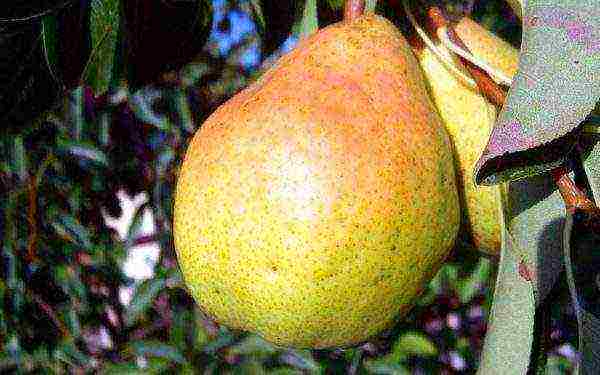 Vera Yellow
Vera Yellow
Another suitable variety for planting in the Moscow region. A tree with a height of more than 6 m, with a pyramidal shape of the trunk, with erect branches of a brown-brown color... Young leaves of light green tones, by autumn change color to dark green shades. Frost-resistant, does not need special care. The pear ripens in mid-September. It differs from others in that it has declines in yield, the fruits become smaller, but after a couple of years the pear again pleases with a large harvest.
Fruits have green hues throughout the summer, but change to yellow-orange colors closer to autumn. Fastens on short stalks, grows 2-3 pears in a bunch... To the taste, the pear is fragrant and fleshy, medium-grained pulp with a thin skin. Good storage capacity, especially in a cool place.
Elegant Efimova
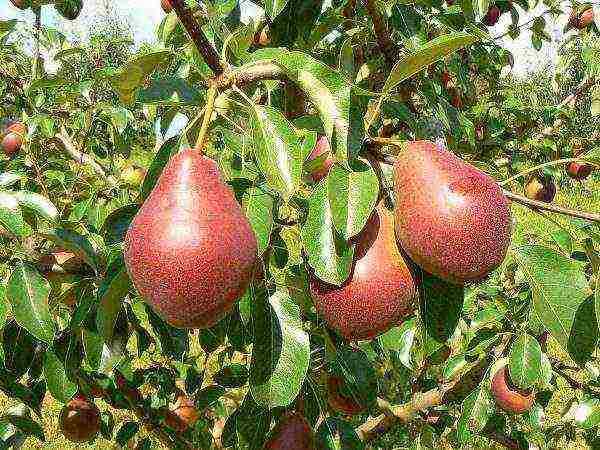 Variety Dressy Efimova
Variety Dressy Efimova
It turned out as a result of crossing the varieties Lyubimitsa Klappa and Tonkovotka. It grows well and gives a rich harvest in the Central Region, the Moscow Region and other nearby regions. High-yielding, winter-hardy, not subject to pests and diseases... The tree is tall, more than 5 m in height, with a dense crown, dark brown, pyramidal in shape. The leaves are small, dark green in color, with smooth edges.
Beautiful appearance of the fruit, red-orange tones are intertwined with green shades. But the fruits are small in size, weighing no more than 120 grams, regular, slightly distant shape. Soft, juicy pulp with a pleasant sweet aroma. The thin skin of the pear is prone to dark spots during the summer. Fruits ripen at the end of August, overripe quickly, so it is better to collect them a little hard, and it is recommended to store them in a cool and dark place.
Venus
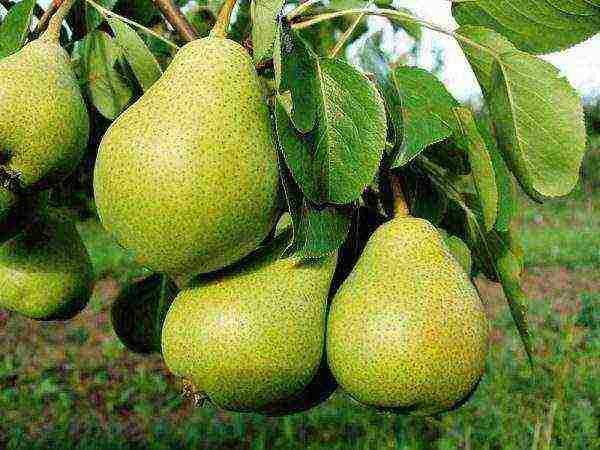 Pear venus
Pear venus
Another popular variety for planting, due to its winter hardiness and unpretentious care. Tree no more than 4m high, the crown is quite spreading, young branches are slightly lowered down, light brown in color. The variety blooms in early spring with white inflorescences with a sweet aroma. The variety also differs in high productivity, an adult tree is capable of producing more than 40 kg of harvest over the summer. Does not need rest, is able to bear fruit annually. In addition, the variety tolerates frosts, diseases and pests quite steadily.
The variety ripens in early autumn, the fruits are large, weighing up to 200 grams... Red-yellow in color, green tones when ripe. The taste is soft, juicy, slightly sour with a thin skin. They are stored for a long time both on the tree and when assembled.
Regardless of the specific variety, of which there are a great many today, the main thing in a pear is its taste and useful microelements, which are so abundant in ripe fruits. Winter, summer and autumn varieties differ from each other not only in taste, but also in the speed of fruit ripening., features of care, and the ability to preserve the fruit. Which variety to choose is up to you.
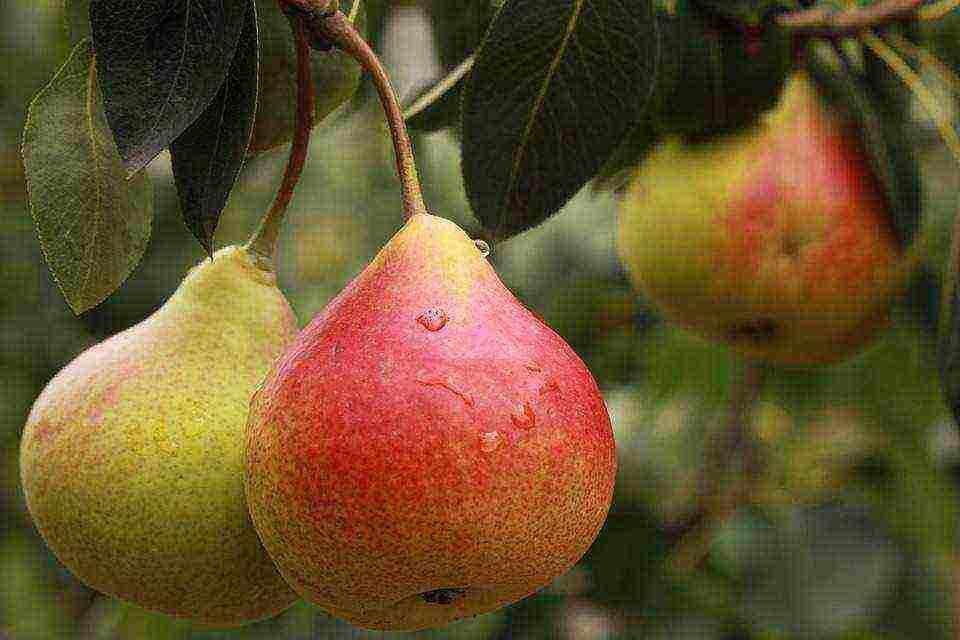
When choosing a variety, the main attention is paid to winter hardiness, and if the pear is acclimatized in your region, it means that it tolerates your winters perfectly and you can safely buy seedlings.
Further, when selecting a variety, the early maturity and yield of the variety are usually considered, well, the taste of the selected variety is of no small importance.
We offer you a selection, by looking through which you can easily find a variety suitable for your region. All these varieties are included in the State Register of Breeding Achievements of the Russian Federation in the central region.
Pear varieties for the Moscow region
These fruit-bearing trees are suitable for growing in central Russia, for the regions of Bryansk, Vladimir, Ivanovo, Kaluga, Kostroma, Oryol, Ryazan, Smolensk, Tver, Tula, Yaroslavl.
Summer pear varieties
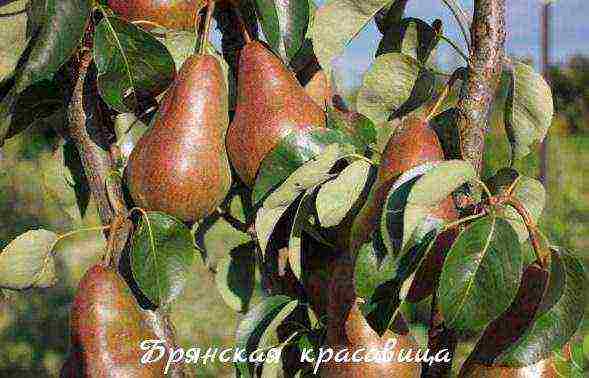
Pear Bryansk beauty: description, reviews, photos
Late summer variety of pears. The tree is medium-sized, medium-growing. The crown is round, of medium density. Shoots are located compactly, the ends are directed upward, rounded, brownish-brown, geniculate, glabrous. Leaves are medium, elongated, short-pointed, dark green, shiny, smooth.
Fruits are large, weighing 205 grams, one-dimensional, elongated pear-shaped, regular in shape. At the stage of maturity, the color is golden yellow, integumentary - in the form of a light tan. Subcutaneous points are small, gray, few of them. The pulp is creamy, medium density, tender, oily, very juicy. The taste is sweet with a faint aroma. Tasting taste score of 4.8 points.
The variety Bryanskaya krasavitsa enters fruiting in the fifth year.
Pear Lada: photos, reviews
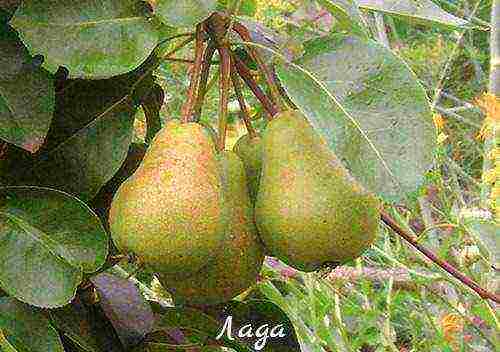
Variety of early summer consumption period. Winter hardiness is high. The variety is scab resistant. It has a high yield, fast-growing, versatile.
Characteristics of the variety
The tree is medium-sized. The crown is conical, dense. Fruits are medium in size, weighing 100-120 grams, wide pear-shaped, wide ribbed. The main color of the skin is light yellow, the subcutaneous points are small, hardly noticeable, the integumentary point is bright red, occupies less than half of the surface of the fetus. The funnel is absent, there is a small influx at the place of attachment of the peduncle. The saucer is narrow, shallow, lumpy. The peduncle is of medium length, thick, slightly curved. The pulp is yellowish-white, tender, juicy, fine-grained, sweet and sour, very aromatic, of good taste. On state variety testing since 1980. Included in the state register in 1993.
Obtained by crossing the varieties Olga and Lesnaya Krasavitsa.
Pear Cathedral: characteristics of the variety, photo
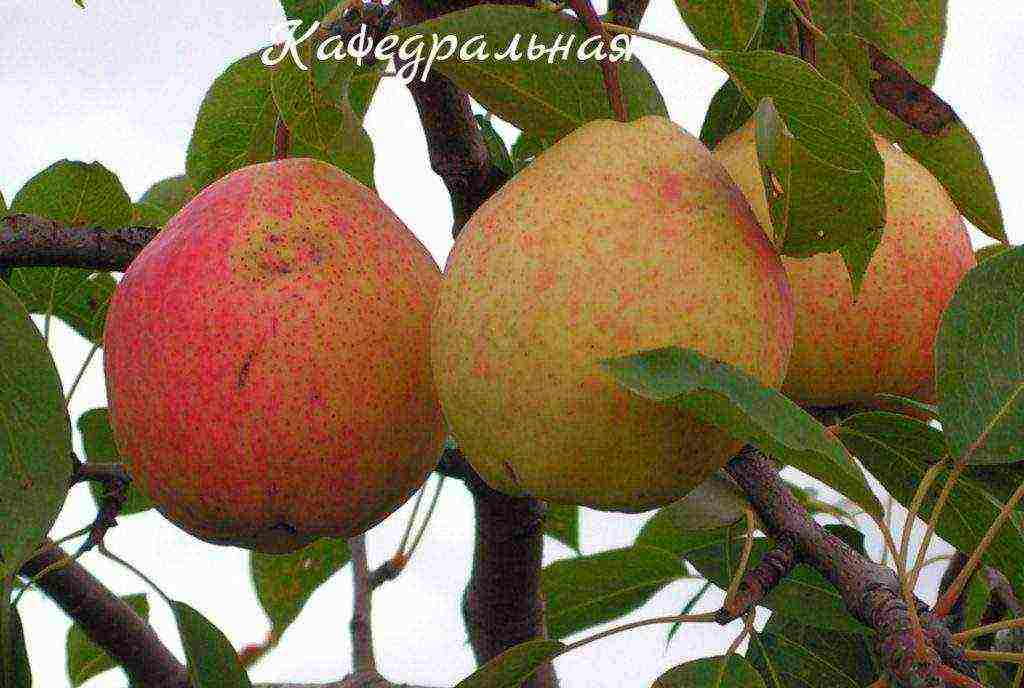
This summer pear variety was included in the State Register for the Central Region in 2001. Medium-sized tree with a conical crown. The leaves are large and medium, oval, light green with coarse nerve.
Fruits are pear-shaped, lumpy, weighing 100-110 grams, yellowish-greenish at the stage of maturity, with a faint blurred red blush. Subcutaneous points are invisible. Pear pulp is white, semi-oily, fine-grained, juicy, sweet and sour taste.
Yield 136.5 centners / ha. Removable ripeness of fruits occurs in the second half of August. The fruits are stored for 10-12 days.
Pear Severyanka: description, photo, yield
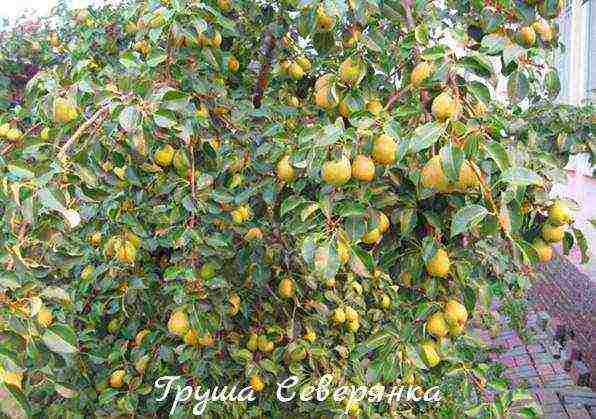
An early summer variety of the Michurin All-Russian Research Institute of Genetics and Breeding of Fruit Plants. Bred through hybridization of 2 varieties - Koperechka Michurinskaya No. 12 (Ussuriyskaya pear x Bere Ligel) x Favorite klappa.
Since 1965, the Severyanka pear variety has been zoned in a number of regions of the Volga-Vyatka, Middle Volga, Ural, West Siberian, East Siberian and Far Eastern regions. But it was most widespread in Bashkiria, Chelyabinsk, Kurgan and Kostanay regions.
The trees are of medium size and growth rates are quite fast. Shoot-forming ability is high. Crohn medium thickened, broadly pyramidal, almost round. The variety has a mixed type of fruiting.
The fruits of the Severyanka pear are not uniform in size, the average weight of the fruit is 80-85 grams, the maximum weight does not exceed 120 grams. The shape of the fruit is truncated-conical. During the period of removable ripeness, the main color of the fruit is greenish-yellow, the integumentary color occupies less than half of the pear's surface in the form of a weak blurred tan. During the period of consumption, the main color becomes more yellow with a slight green, and the integumentary color takes the form of a dull pink blush. The skin on the fruit is dull, rather thick and firm, but not too rough. There are few seeds in the fruits, they are large, dark brown in color. Creamy pulp, medium density, normal taste - crispy, juicy, slightly aromatic, sour-sweet, impatient. Pears are universal for their intended purpose.
The period of removable ripeness of Severyanka falls at the end of the first decade of August. The consumption period lasts up to 2 weeks (if the crop is stored in a cellar), after which the pulp begins to turn brown. If you eat the fruits a little earlier (5-7 days before full ripeness), then the terms of consumption of fresh pears can be extended to two months when stored in the refrigerator. It is also worth noting that although the fruits are very firmly held on the trees, when fully ripe, they completely crumble in 2-3 days. In this regard, it is also recommended to eat fruits slightly ahead of time, 3-5 days earlier.
Pear Severyanka belongs to the early-fruiting and high-yielding varieties. The first crop can be harvested as early as 3-4 years after planting, after which the yield increases rapidly. A tree at the age of 6-7 years gives up to 20 kg of fruits.With proper care and watering, the average yield of an adult tree reaches 60 kg, and in especially favorable years - 110 kg of fruits from one tree.
Pear August dew: photo, description
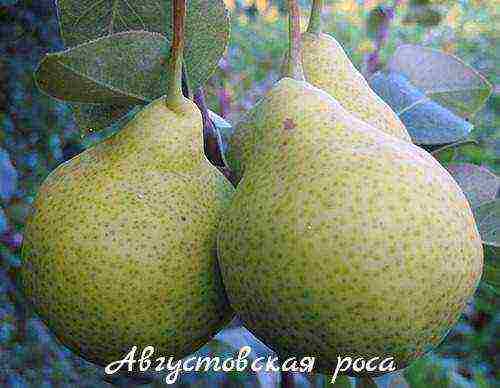
A popular summer pear variety, bred by crossing the Tenderness variety with the Australian Triumph Pakgama variety. Since 2002, the variety has been zoned in the Central Black Earth Region.
Trees up to 3 meters high are characterized by rapid growth rates. Crohn medium thickened, slightly drooping shape. Leaves are medium in size, oblong-ovate, serrated at the edges, short-pointed at the ends, colored dark green.
Pear fruits August dew are medium in size, average weight 120-150 grams, one-dimensional, aligned, short-pear-shaped. During the period of removable maturity, the fruits have a green color and are devoid of integumentary color. During the consumer period, the main color becomes greenish-yellow, a cover color appears - in the form of a very weak blush on an insignificant part of the fruit. The skin is smooth, dull, with numerous subcutaneous punctures. The pulp is white, fine-grained, tender, melting, very juicy, harmonious sour-sweet taste. According to a 5-point tasting scale, the taste of the August dew pear is estimated at 4.6 points.
Fruit picking time is in mid-September. Ripe fruits are firmly held on the branches. In a cool place, the shelf life does not exceed, as a rule, 2 weeks. In the refrigerator, pears can retain their taste and freshness for up to 3 months.
The early maturity of the August dew variety is high, the trees bear fruit regularly, starting from the 3-4th year after planting. Highly productive variety. Already in the 4th year after planting, up to 15 kg of fruits can be harvested from one tree. In the period of full fruiting, the yield reaches 200 c / ha.
The level of winter hardiness and drought resistance of this pear is high. Trees are resistant to major diseases and pests, leaves and fruits are not affected by scab. The variety is unpretentious in care.
Pear Favorite Klapp: description, photo
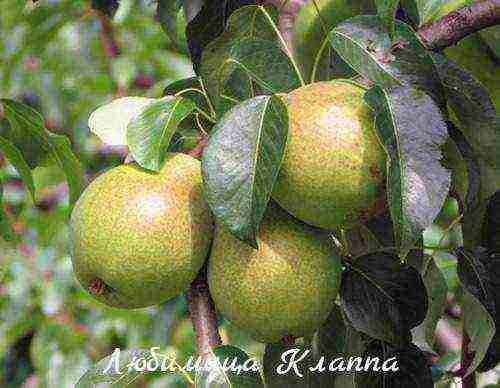
Pear variety of American selection. Other names - Favorite, Favorite Clapp. The variety is recognized as one of the best summer pear varieties, as it is ideal for production, home and farm gardening.
Trees are vigorous. At a young age, they are distinguished by rapid growth rates and form a thin pyramidal crown. With age, the crown becomes sparse, slightly "weeping" (with hanging branches) and acquires a wide-rounded shape. The average life span of this pear tree is up to 70 years.
Pear fruits Klapp's favorite is large, average weight is about 200 grams. The shape of the fruit is short pear-shaped, with a large expansion towards the apex. The skin on the surface is delicate, smooth, slightly bumpy. According to the main color, the fruits are yellowish-green, when fully ripe they are colored yellow, the integumentary color is noticeable on the illuminated side of the fruit in the form of a bright carmine blush. The subcutaneous points are small, numerous, and hardly noticeable. Rarely, a slight rustiness may be present on the fruits - at the base of the apex in the form of small specks. The pulp is white, very juicy, tender, melting, with a light aroma, very good sour-sweet taste.
The purpose of the fruits is universal - due to their excellent taste and beautiful appearance, they are used mainly fresh, but are also suitable for canning, drying, etc.
Removable ripeness of fruits - in the middle of August.
The early maturation of the Lyubimitsa Klappa variety is low: the fruiting period begins in trees usually 7 - 8 years after planting in the garden.
Pear Marble: yield, photos, reviews

Summer, fruitful, dessert pear variety. Winter hardiness is above average. Relatively resistant to scab. The early maturity is above average.
The tree is medium-sized, with a broad-pyramidal crown of medium density.
Fruits are medium in size, weighing 120-160 grams, round-conical in shape, smooth. The skin is greenish-yellow with noticeable rusted subcutaneous punctures. The cover color is brown-red, blurred with strokes. The funnel is of medium depth, narrow with an influx in the area of the stalk attachment, slightly corroded. The saucer is small, wide, slightly ribbed. The peduncle is of medium length, thick, curved. The pulp is white or creamy, tender, coarse-grained, very juicy, melting, sweet, of excellent taste. The Marble pear variety was included in the state register in 1965.
The variety was obtained in 1938 by crossing Bere winter Michurina x Lesnaya krasavitsa.
Pear Chizhovskaya: variety description
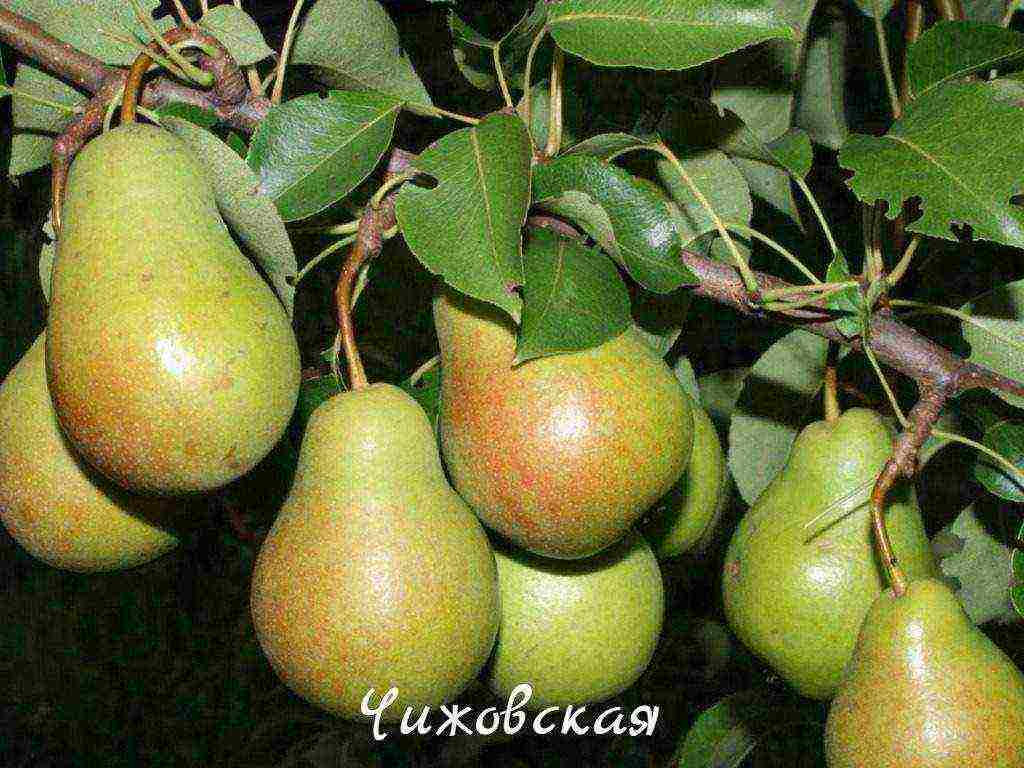
The variety is fast-growing, late summer consumption with high winter hardiness, high productivity and scab resistance. Universal. The crown is oval, of medium density.
Fruits are medium in size or below average, weighing 100-120 grams, elongated, pear-shaped, elongated. The surface of the skin is smooth, matte, dry. The main color is yellowish-green with noticeable green small subcutaneous dots, the integumentary color is absent or very weak, reddish. The funnel is narrow, of medium depth, smooth. The saucer is small, narrow, smooth. The peduncle is short, of medium thickness, straight or slightly curved. The pulp is dense, juicy, semi-oily, sour-sweet, very good taste.
The Chizhovskaya pear variety was included in the state register in 1993.
Obtained by crossing the varieties Olga and Lesnaya Krasavitsa.
Pear Rogneda: variety description, reviews, photos
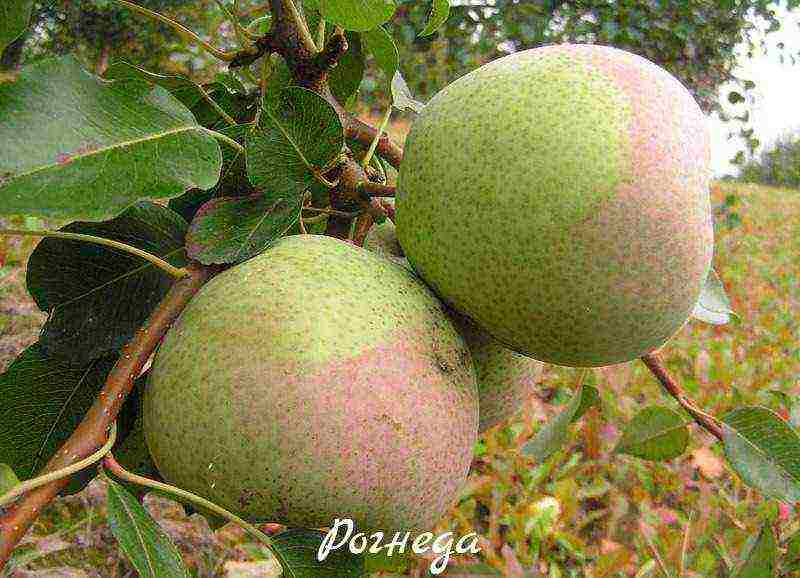
Late summer pear variety. A tree of medium vigor with a broad-pyramidal dense but compact crown.
Fruits are round, smooth, shiny, with an average weight of 125 grams. When ripe, the color is light yellow, the integumentary color is absent or appears on individual fruits in the form of a weak blurred red blush. The pulp is beige-white, medium density, juicy, slightly oily, good sweet taste with nutmeg flavor and aroma. Taste 4.1-4.2 points. Fruits reach removable maturity in the second or third decade of August. The period of fruit consumption is late August - early September.
Average yield 140.5 c / ha.
The Rogneda pear variety was included in the State Register of the Russian Federation in 2001.
Pear Prominent: photo, description of the variety
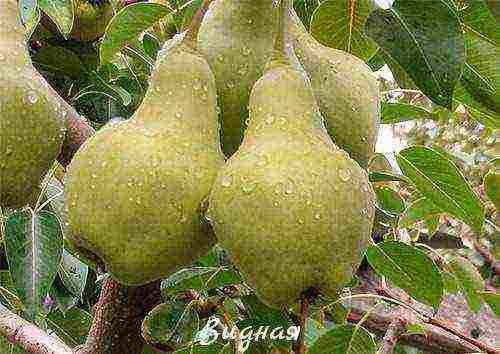
Summer variety of pears with high winter hardiness. The tree is medium-sized with a narrow-pyramidal crown. Shoots curved, rounded, brown, glabrous. The leaves are oblong, green, smooth.
Fruits with an average weight of 120 grams, elongated pear-shaped, tuberous. The peduncle is short, oblique. The funnel is shallow. The color is greenish-yellow with a slight tan. Subcutaneous dots are gray, hardly noticeable. The pulp is white, tender, juicy. The taste is 4.4 points.
The average yield over the years of testing was 97 c / ha.
The Vidnaya pear variety is included in the State Register of the Russian Federation and approved for cultivation in the Central Region.
Autumn varieties of pears with photos and descriptions Pear Moskvichka
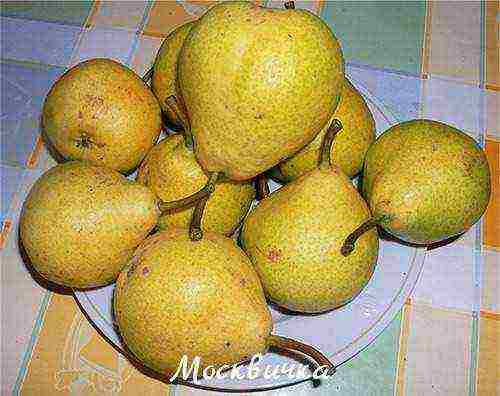
In 2001, this autumn pear variety was included in the State Register for the Central Region. The crown is dense, medium-leafy, funnel-shaped in shape at a young age, conical in the period of full fruiting. The flowers are non-double, medium-sized, cupped in shape, the corolla is white.
Fruits are medium, weighing 120-130 grams, round-shirokokonicheskie and broadly ovate, not even in size. At full maturity, the fruits are yellowish-green, yellow, without integumentary coloration. The skin is dense, thin, oily. The pulp of the fruit is yellowish-white, very juicy, fine-grained, semi-oily, sour-sweet. Tasting score 4 points. Removable maturity occurs in the second half of September.
Pears are stored for 25-30 days. The average yield is 126.5 c / ha, exceeding the control variety Lyubimitsa Yakovleva.
Pear Beauty Chernenko: description and characteristics of the variety
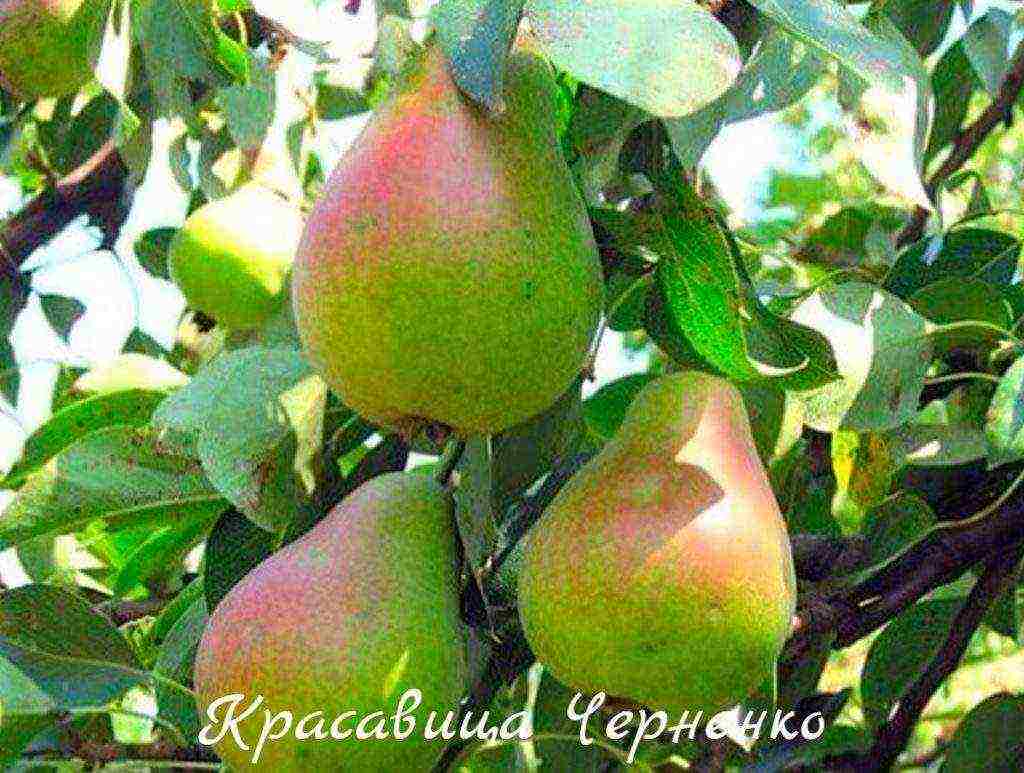
This autumn pear variety was included in the State Register in 1996. The trees are vigorous, with a sparse narrow-pyramidal crown.
Fruits are large, weighing 150-200 grams, medium-sized, pear-shaped. The peduncle is long, curved. The skin is soft, with a slight bloom of fat. Fruit color is greenish-yellow with a blurred red blush on most of the fruit. The pulp is white, of medium density, juicy, tender, semi-oily, melting. Fruits of high commercial and consumer qualities. Tasting score 4.3 points.
Winter hardiness at the level of zoned varieties. Fast-growing, high-yielding, average yield 127 c / ha, which is 2 times higher than the control variety. Scab resistant variety.
Flaws: high inconvenient crown, with a plentiful harvest, the fruits become smaller.
Pear of Memory of Yakovlev: reviews, photos, description
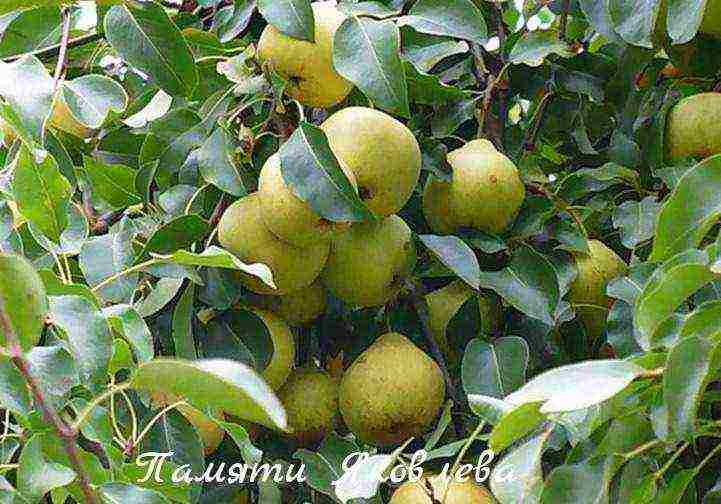
A productive variety of early autumn consumption with excellent winter hardiness. Fast growing and scab resistant.
Fruits are medium in size, broadly pear-shaped, slightly ribbed, weighing 125 grams. The skin is light yellow with a faint orange blush. There is no funnel. The saucer is narrow, of medium depth. The peduncle is long, of medium thickness, straight. The pulp is semi-oily, sweet with a little acid, with a pleasant aroma.
The pear variety in Memory of Yakovlev was included in the state register for the Russian Federation in 1985.
Pear Lyubimitsa Yakovleva: characteristic of the variety
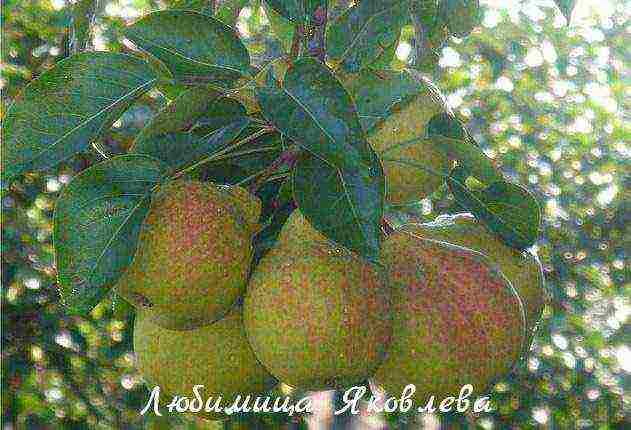
A fast-growing, table variety of pears for autumn consumption. Winter hardiness is above average. Affected by scab. The yield is average. Partially self-fertile. The crown is wide-pyramidal, thin.
Fruits are medium and above average in size, weighing 130-190 grams, rounded-rhombic or rounded-double-coconical, wide ribbed. The main color is greenish-yellow with large numerous gray subcutaneous punctures, the integumentary color is weak, blurred, dark red. The funnel is wide and shallow. The saucer is wide, shallow, ribbed. The peduncle is long, thin, straight. The pulp is coarse-grained, coarse, medium juiciness, mediocre taste.
The variety Lyubimitsa Yakovlev was included in the State Register in 1965 in the Central (Vladimir, Moscow regions), Central Chernozem (Belgorod, Lipetsk, Tambov regions), Srednevolzhsky (Penza region) regions.
Pear Memory Zhegalov, description, reviews, photos
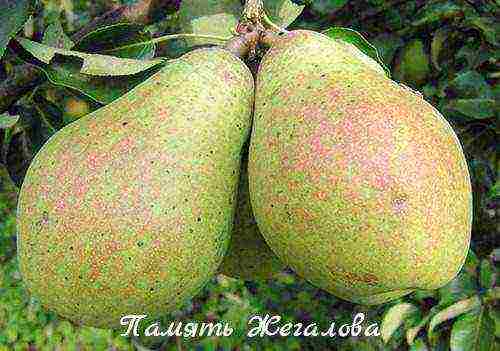
Autumn pear variety included in the State Register for the Central Region. The tree is medium-sized with a fast-growing sparse crown of a conical shape. Leaves are medium, elongated, ovate.
Fruits are regular pear-shaped, with an average weight of 120 grams, greenish or lemon-yellow at the stage of ripeness. The cover color appears in rare, well-lit fruits in the form of a slight reddish blush. The pulp is light yellow-white, very juicy, tender, melting, semi-oily, sour-sweet, slightly tart. Tasting taste assessment 4.2 points. Removable ripeness of fruits occurs in the second or third decade of September. Pears of the Pamyat Zhegalova variety are stored for up to 25-30 days. The average yield is 122 c / ha.
Pear Veles: description, photo
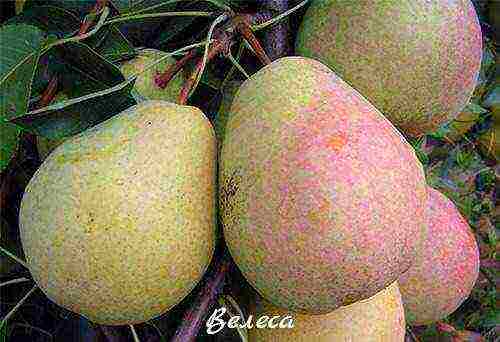
Autumn pear variety with high winter hardiness. The ovary is resistant to frost up to - 2 ° C. The tree is medium-sized with a drooping pyramidal crown. Shoots are arcuate, rounded, cherry-brown, glabrous. Leaves are medium, oblong-oval, yellow-green, smooth, shiny, with gentle nerve and curved edges.
Fruits with an average weight of 120 grams, regular shape, slightly beveled. The peduncle is slightly curved. The funnel is blunt-conical. The saucer is small, wide, smooth. The color is greenish-yellow with a slight orange tan. The subcutaneous points are small, gray, subtle. The pulp is creamy, semi-oily, tender and juicy. Fruit tasting score 4.6 points.
Average yield - 126 kg / ha.
The Veles pear variety was included in the State Register for the Central Region in 2001.
Pear Faithful: description, photo

Late autumn, fruitful variety. Medium tree with drooping crown. Shoots curved, rounded, reddish-brown, glabrous. Leaves are ovoid, green, smooth.
Fruits are pear-shaped, slightly beveled, with an average weight of 100 grams. Ripening, the color is greenish-yellow with a slight tan. Subcutaneous dots are gray, hardly noticeable. The pulp is creamy, tender, semi-oily, very juicy. The taste is 4.4 points.
Winter hardiness is high, at the level of the Bessemyanka variety. The ovaries are resistant to frost up to -2 ° C.
Average yield - 232 kg / ha.
The Vernaya pear variety is included in the State Register for the Central Region of the Russian Federation.
Pear Thumbelina: variety description, photo
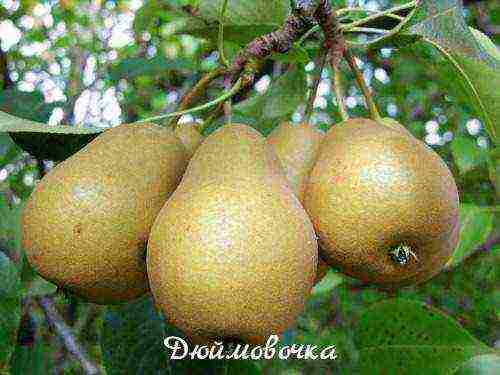
Autumn, winter-hardy pear variety for central Russia. The tree is medium, with a rounded crown. Shoots are round, brownish-brown, glabrous. Leaves are elliptical, green.
Fruits are small, with an average weight of 70 grams, pear-ovate. The peduncle is long, thin, erect. There is no funnel. When ripe, the color of the pears is golden yellow with a slight tan. The pulp is creamy, tender, semi-oily, very juicy. Taste 4.8 points.
Yield: 68 c / ha.
The pear variety Thumbelina was included in the State Register for the Central District in 2001.
Pear Just Maria: description, photo, reviews
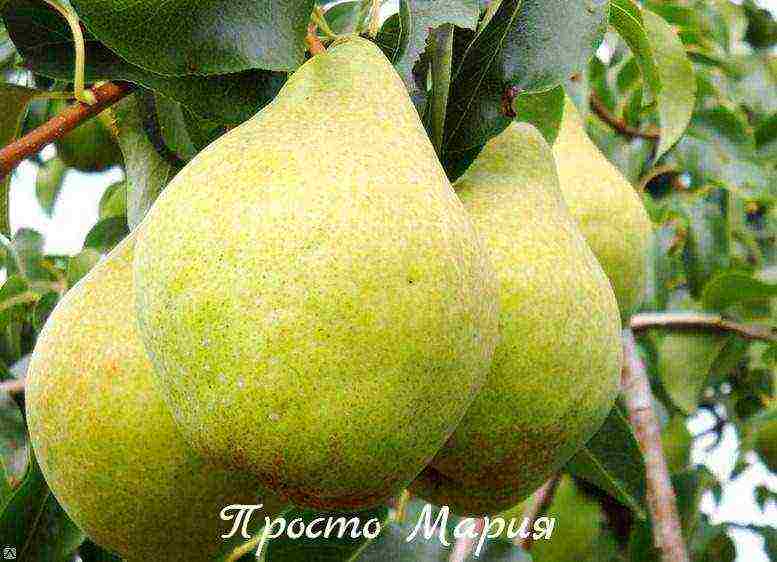
Autumn variety of pears. The tree is medium-sized, fast-growing. Crohn of medium density, wide pyramidal. Leaves are medium, oblong, short-pointed.
Fruits with an average weight of 180 grams, pear-shaped. The funnel is shallow, blunt-conical. No rustiness. The calyx is not falling, open, the saucer is small, wide, smooth. The main color at the time of removable maturity is light yellow, the integumentary color - on the smaller part of the fruit in the form of a light tan, pink. In the state of consumer maturity, the main color of the fruit is light yellow, the integumentary color - on the smaller part of the fruit in the form of a slight tan, blurred, pink. The pulp is yellowish-white, of medium density, tender, oily, very juicy, fine-grained, sour-sweet taste with a weak aroma. The fruits contain: sugar 8.15%, acid 0.1%, vitamin C 3.1 mg%. Tasting taste score of 4.8 points.
Average yield: 72 kg / ha (subject to agricultural technology).
The pear variety Prosto Maria was included in the State Register for the Central Region of the Russian Federation in 2003.
Winter varieties of pears with photos and descriptions Pear Belorussian late
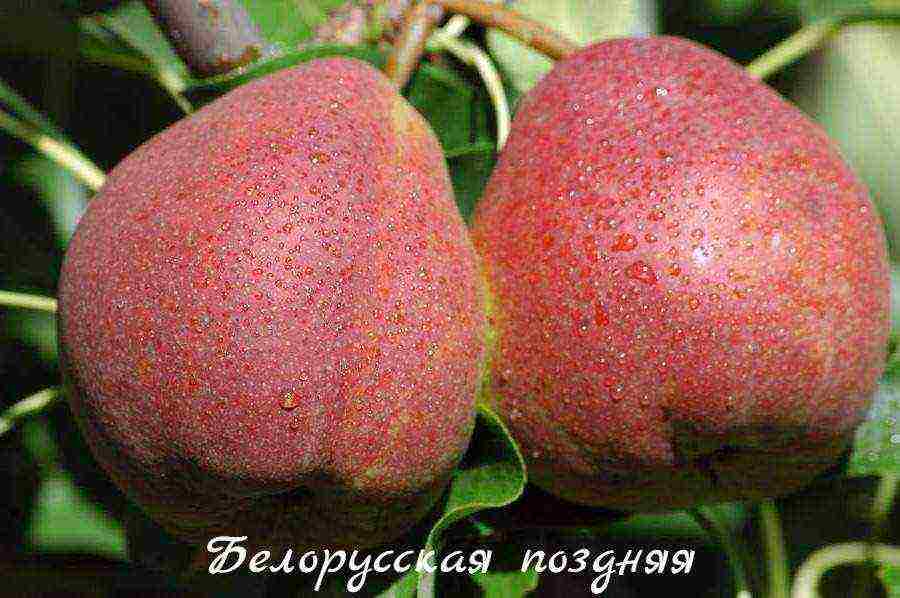
Winter variety of pears. The tree is medium-sized, with a rounded dense crown. The leaves are small, oblong, elliptical, long-pointed, light green in color.
Fruits are medium, weighing 110-120 grams, medium one-dimensionality, wide pear-shaped. The main color is orange-yellow, the integumentary color is crimson, blurred. The pulp is white, medium density, tender, oily, juicy. The taste is sweet and sour, with a light refreshing acidity. Tasting score 4.2 points. Yield: 122 c / ha.
The pear variety Belorusskaya late was included in the State Register of the Russian Federation in 2002.
If you grow any of these pear varieties or others in the Moscow region, tell me which ones do you think are the best? What do you like about your varieties? If possible, attach a photo of your crop to the comments. Thank you!
Your reviews and additions to the description will help many gardeners choose for planting the best varieties of pears.
The cultivation of pears in central Russia was not so long ago treated with caution. More whimsical, in comparison with an apple tree, it did not tolerate sudden changes in temperature, frost.
Thanks to the work of breeders, today the best varieties of pears have been bred for central Russia, which grow and bear fruit well. Read on for our selection of pear varieties with descriptions and photos.
Basic requirements for pear varieties for Central Russia
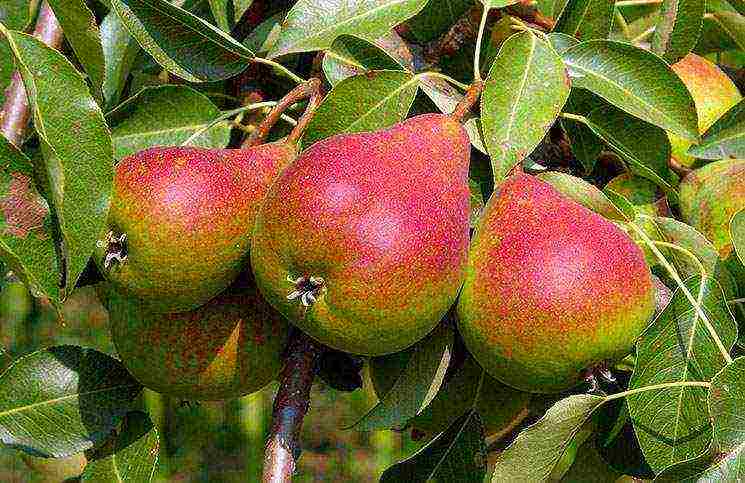
The pear is demanding on soil fertility, illumination, warmth and care. For her, choose a sunny place with fertile soil. If the soil on the site is poor, specially prepared soil is used to fill the large planting pit. The pear will more than thank the gardener for such care. Long-lived pear trees bear fruit for decades.
The best pear varieties for central Russia must meet the following requirements:
- Winter hardiness.For many years, due to its weak winter hardiness, the pear was considered a minor crop in central Russia compared to the apple tree. Modern pear varieties are even more hardy than some apple varieties.
- Taste properties. By choosing sweet and delicate varieties, you can grow in the middle lane the same delicious fruits as in the south.
- Productivity. Depends heavily on planting and grooming.
- Early maturity. Most varieties begin to bear fruit in 3-5 years of life, some have to wait even 8 years.
- Self-pollination. Many pears are incapable of such a process. You should focus on at least a partially self-pollinated variety.
According to the harvest time, all varieties are divided into summer, autumn and winter.
Early (summer) varieties
The early varieties of pears, which are in constant demand, allow to get a good harvest in the middle of summer or closer to the beginning of autumn. Such fruits have a very rich taste with a sour aftertaste, since they do not have time to fully absorb in a short period of solar activity.
Bashkir summer
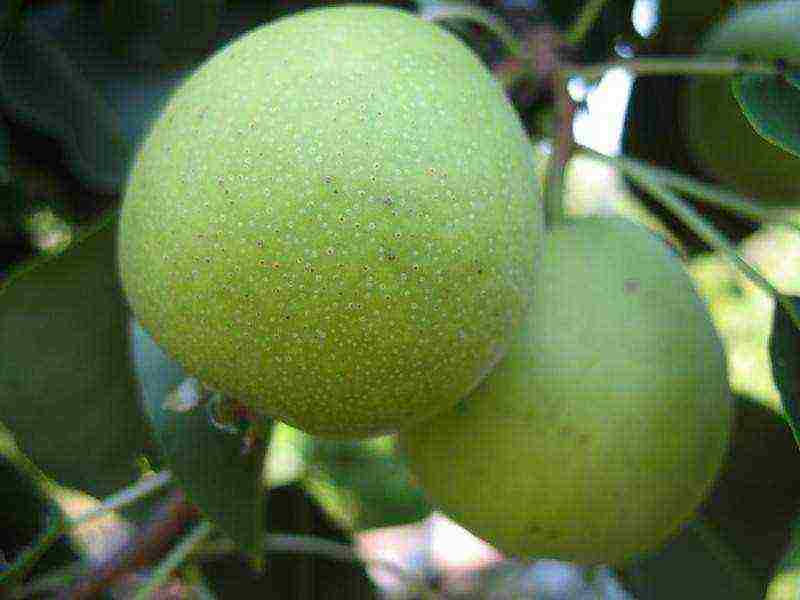
A versatile, winter-hardy, fruitful (45-50 kg per tree), but not fertile variety. A medium-sized tree with a compact, rounded-pyramidal crown of medium density. Greenish-yellow fruits with a slight blush weigh about 100 g. White grainy pulp of medium density with good taste and aroma.
The messenger
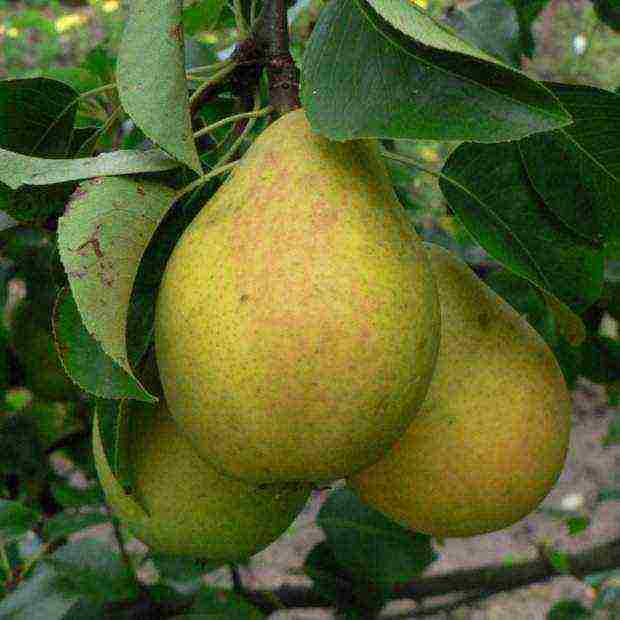
Fast-growing table variety, fruitful, winter-hardy, scab resistant. Medium-sized tree with a sparse back-pyramidal crown. Ribbed-lumpy small (50-60 g) yellow fruits with a slight tan on a long stalk have a sweet taste and light creamy, slightly juicy aromatic pulp of medium density, which liquefies when ripe.
Dessert Rossoshanskaya

Fast-growing, versatile, productive (about 70 kg of fruits from one tree), winter-hardy variety with a sparse, wide-pyramidal crown. Scab resistance is relative. Self-sterile. Large greenish-yellow fruits with a slight blush weigh about 200 g. The saucer and funnel are wide, the stalk is thick and curved. Delicate, juicy, white pulp of medium density has an excellent taste and aroma.
Children
One of the varieties with non-simultaneous, but the earliest ripening period. Winter-hardy, with high frost resistance of the ovaries. A vigorous tree has a compact crown, appreciated by gardeners for its durability. Fruits are bright yellow, with an orange blush, weigh about 80 g. The saucer is small, the funnel is absent, the stalk is short. Very tasty, semi-oily, tender and juicy creamy pulp. The yield from one tree reaches 20-30 kg.
Thumbelina
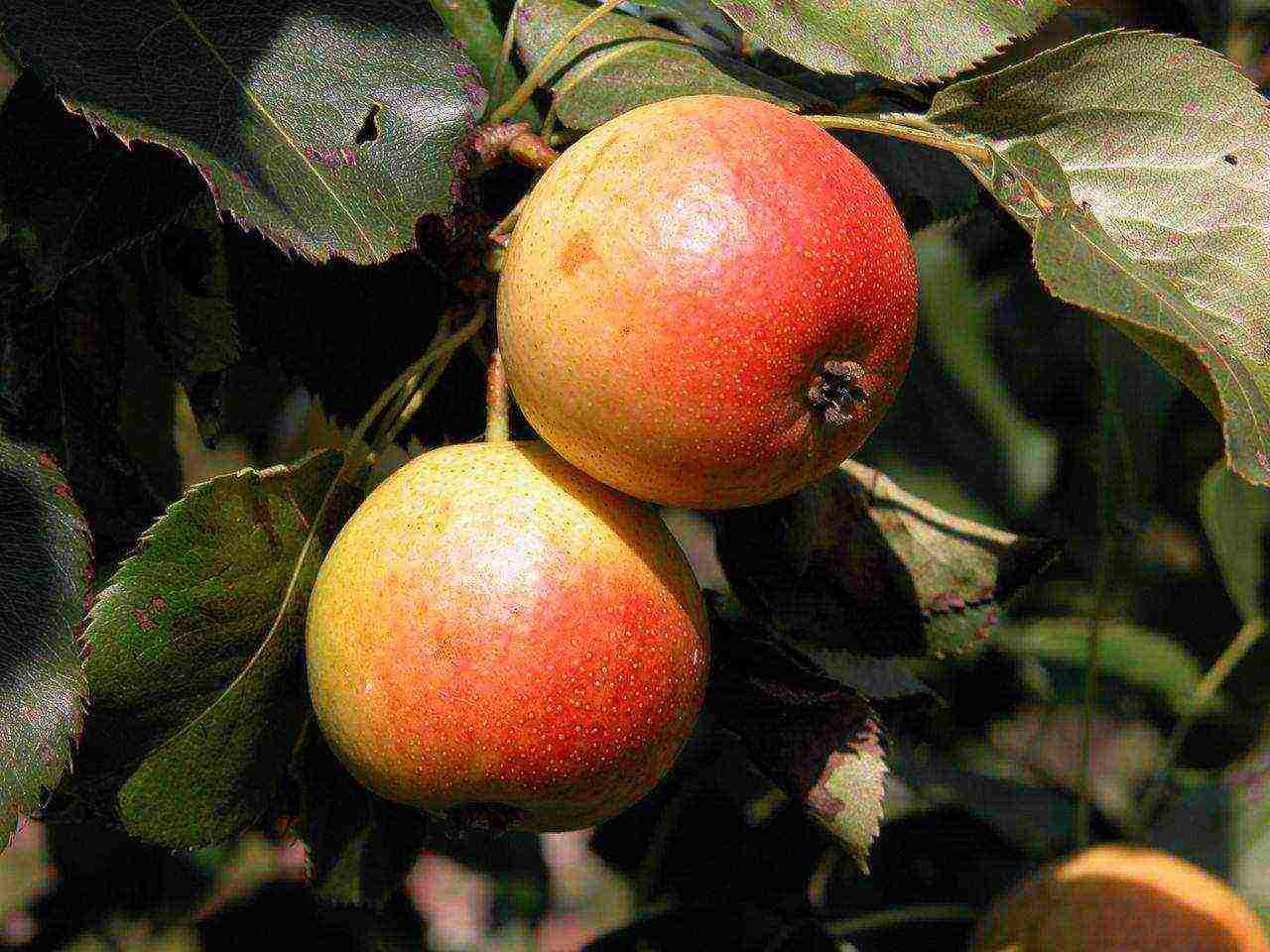
Low-growing (1.5 m), winter-hardy table variety, distinguished by non-simultaneous ripening of fruits and average yield. A medium-sized tree has a dense, rounded crown. Small, brownish-yellow, rusty fruits weighing 60-70 g without funnel, with tender, creamy, very juicy and sweet pulp. The yield reaches 45-50 kg per tree.
Isolde
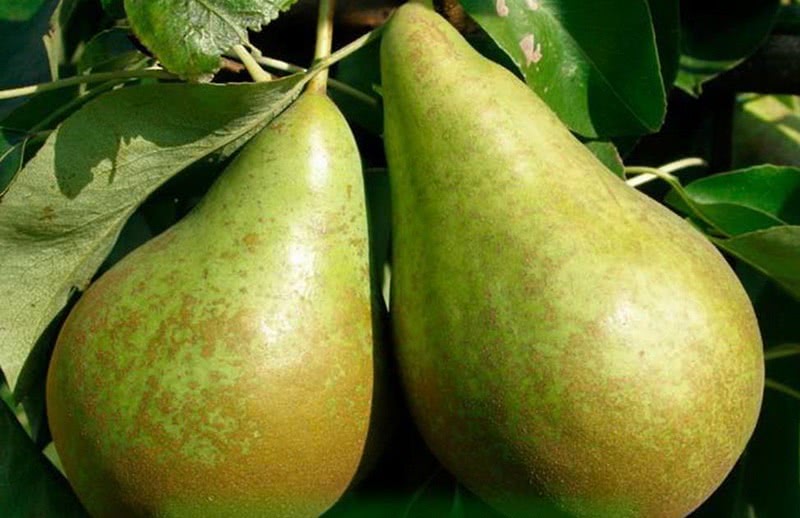
A productive early variety of German selection, resistant to frost and pear scab. A tree with a wide crown grows moderately quickly, ovaries form on the shoots. Bears fruit in the 3rd year. It is characterized by a regular abundance of juicy, medium and large (from 160 to 230 g) fruits with an attractive appearance and a bright red blush.
Cathedral
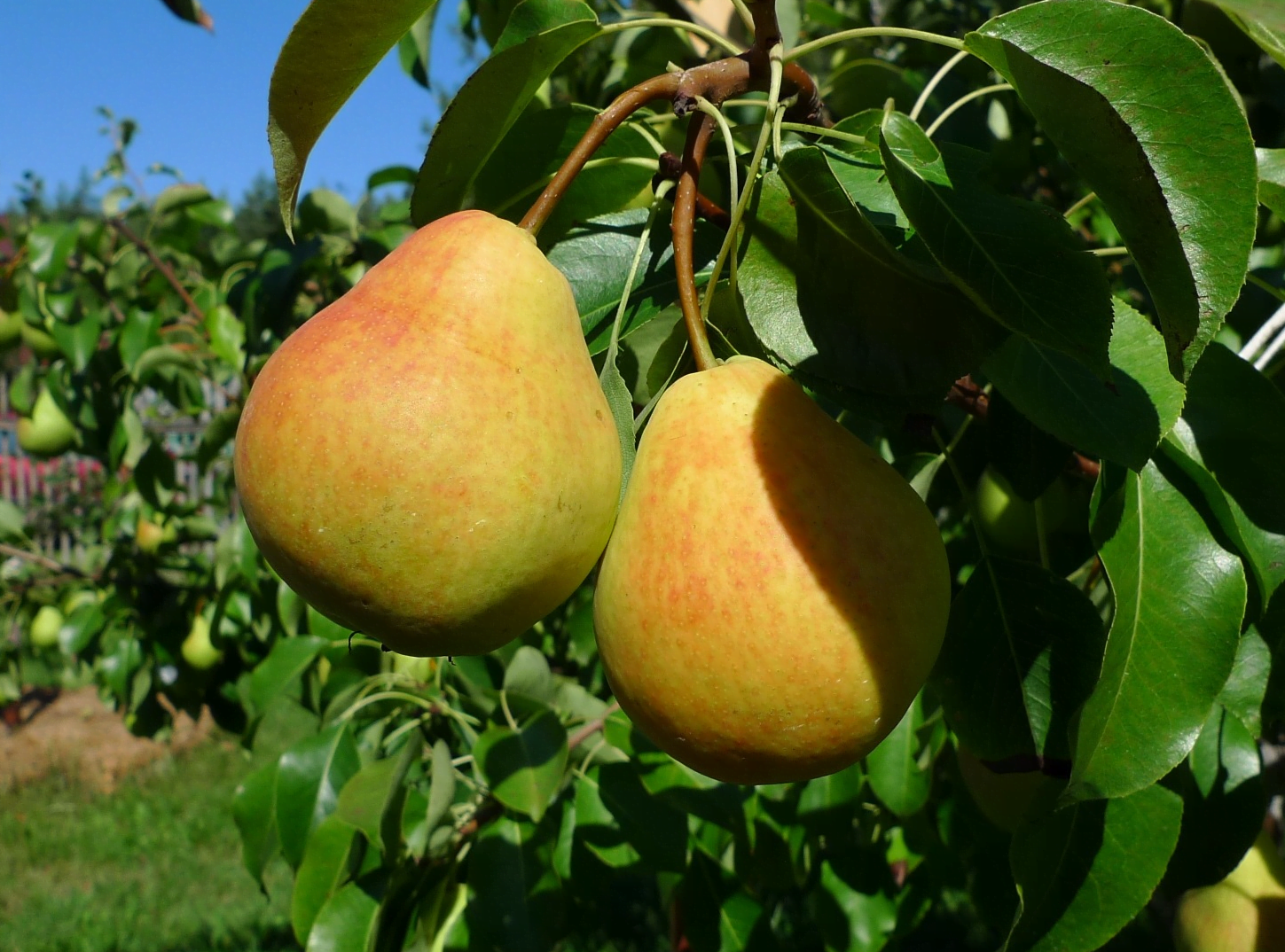
Scab-resistant, versatile, early-growing, winter-hardy variety. A medium-sized tree has a dense, rounded crown. Average yield - 35 kg per tree. Fruits, bright yellow with a red blush, without a funnel, with a shallow saucer and a thick beveled stalk, weigh about 120 g. The semi-oily, juicy, dense pulp has a wonderful taste and aroma.
Space
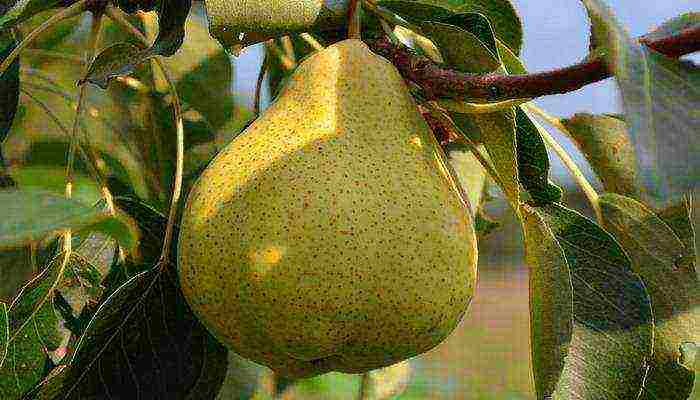
Low-fruiting table variety with high yield (up to 150 kg per tree in some years), medium winter hardiness, relatively resistant to scab. Fruits, greenish-yellow with a slight blush, without a funnel, with a wide saucer.Fine-grained, sweet, juicy white flesh.
Marble
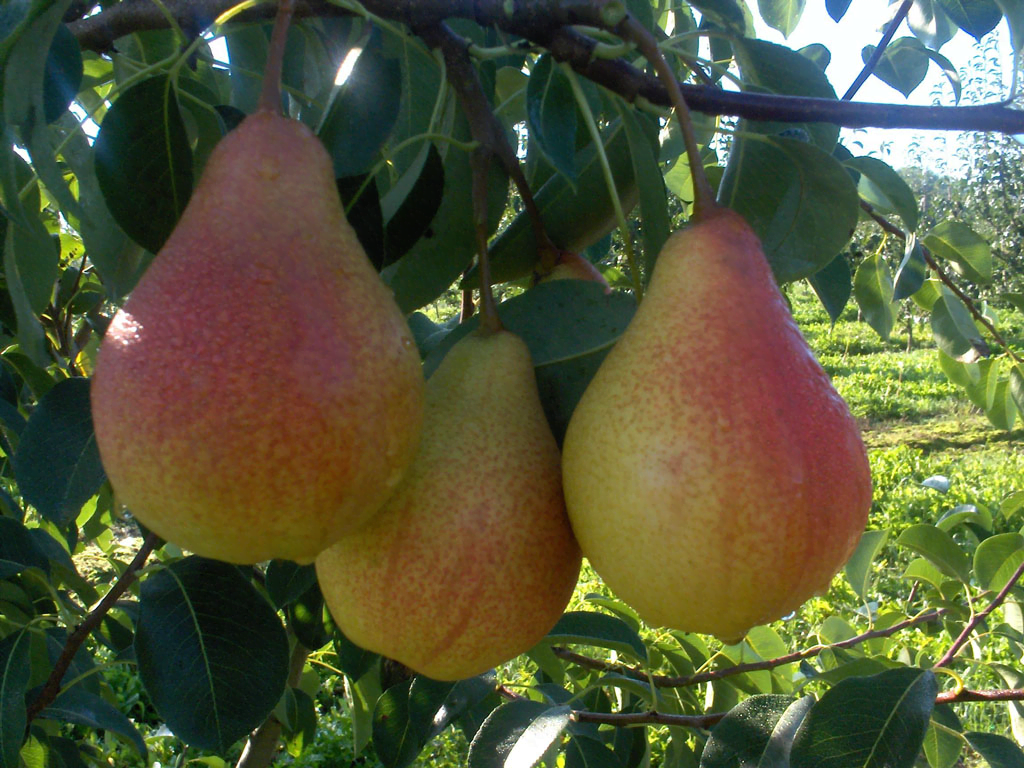
Yielding (about 90 kg per tree) and winter-hardy dessert variety. Relatively resistant to scab, early-growing. A medium-sized tree has a broad-pyramidal crown of medium density. Green-yellow fruits with a blurred blush or streaks and rusty subcutaneous dots weigh about 150 g. The saucer is small, the funnel is narrow, the stalk is inflated. Melting, juicy, coarse-grained, tender, juicy, creamy pulp has an excellent taste.
Oryol summer
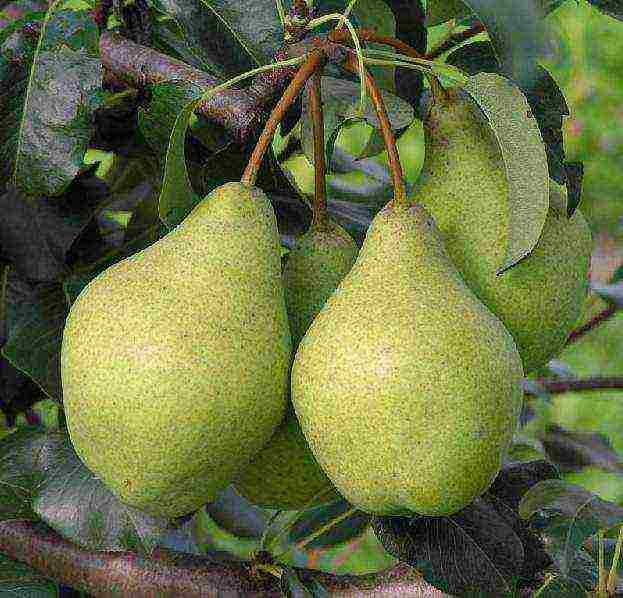
Yielding (35-40 kg per tree per season), early-growing, versatile variety with annual fruiting. Average winter hardiness, relatively resistant to scab. The tree is tall, with a broad-pyramidal crown of medium density. Large (250 g) greenish-yellow fruits with a shallow saucer, without a funnel, have a thick long stalk. Delicious, juicy, dense, semi-oily white pulp with a weak aroma.
Early July
A favorite pear variety for gardeners, which gives a stable yield (on average 60-65 kg per tree) every year. Fruits of the same size (weight 100-120 g) have a regular pear-shaped shape and a pronounced taste with a predominance of sweetness. Elastic flesh practically does not darken in the open air. The variety is suitable for juicing and fresh consumption. Not recommended for preservation because of the rapid loss of flavor saturation.
Rogneda
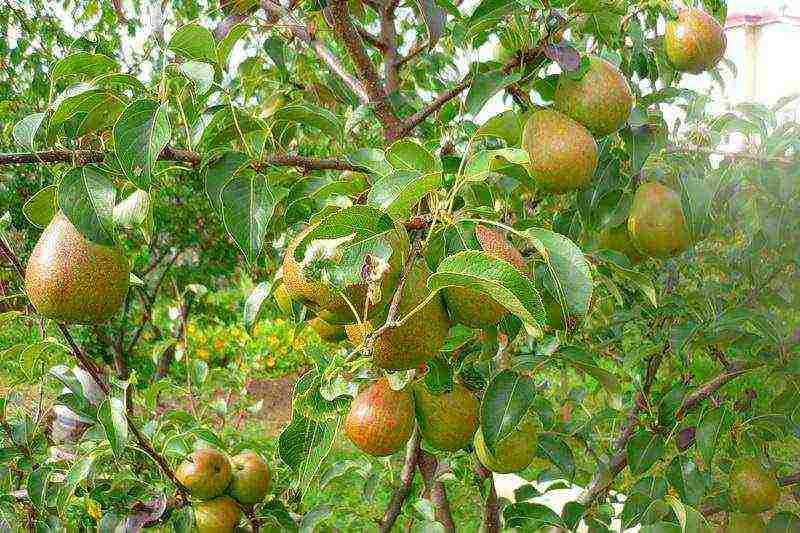
High-yielding (about 90 kg per tree), fast-growing, versatile variety with annual fruiting. It is resistant to scab. Medium-sized tree with a dense, compact, wide-pyramidal crown. Yellow, with a bright red blush, fruits with a deep funnel and a wide shallow saucer have a short peduncle. Fine-grained, juicy, dense pulp with sweet and sour taste and rich aroma. The fruit is characterized by an almost complete absence of acid.
Early ripening
Annually fruiting, disease and frost resistant variety. The tree is tall, fast-growing, with a pyramidal crown, begins to bear fruit in the 5th year. Fruits are uniform in size, small, with thin skin. Due to its soft and juicy pulp, without astringency, it is mainly used fresh and for making juices. Prone to defeat by moniliasis.
Autumn varieties
Autumn pears ripen in mid-September. They must be removed from the trees slightly unripe, avoiding falling off. After a few days of storage in a cool, dark place, they will be ready to eat.
Academic 4-112
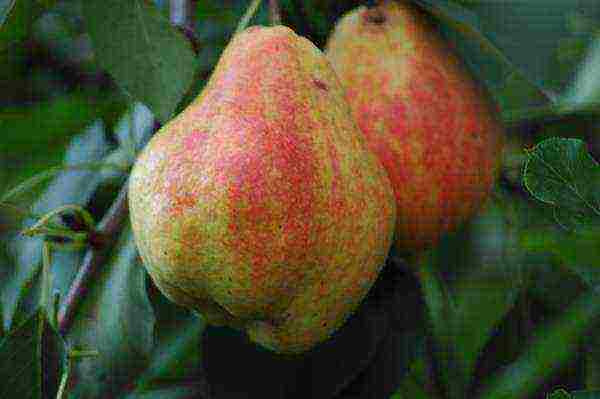
A universal variety with an average (50 kg per tree) yield and winter hardiness, it is resistant to scab. The dense compact crown has a wide pyramidal shape. The fruits are lumpy, pear-shaped, weighing from 130 to 150 g. The skin has a yellow main and dark-burgundy integumentary color. The saucer is ribbed, wide, the funnel is narrow and shallow. The thick peduncle is of medium length. Semi-oily, white, dense, juicy pulp tastes sweet and sour, with a weak aroma.
Bashkir autumn
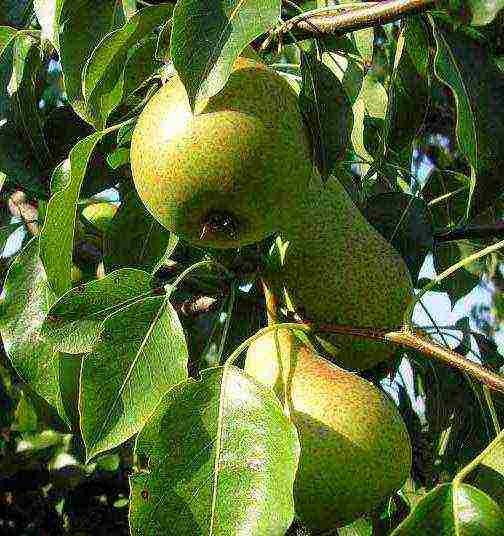
Early autumn high-yielding (70-80 kg per tree) table variety, relatively resistant to scab, winter-hardy. The fruits are elongated pear-shaped with a thick curved peduncle, a wide saucer and a funnel weigh about 75 g. The yellowish-green skin is covered with a blurred red blush on most of the fruit. Juicy fine-grained pulp of medium density has a creamy hue, medium aroma and sweet and sour taste.
Bergamot Moscow
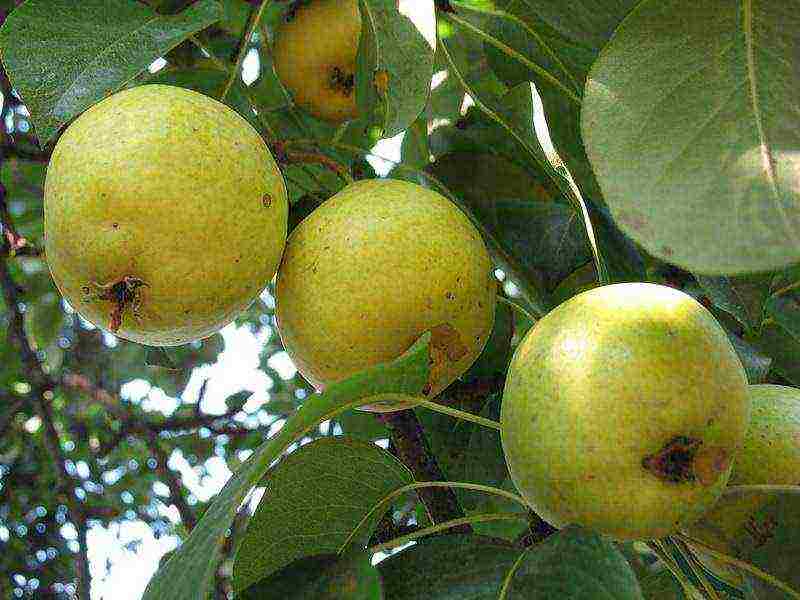
A versatile variety with an above average winter hardiness and an average yield (20 kg per tree), it is resistant to scab. The crown of the tree is sparse, broadly oval. Rounded smooth fruits weighing 150-160 g with a yellowish-green skin have a weak pinkish integumentary color and well-visible large subcutaneous dots. The peduncle is thick, short, straight. The saucer is ribbed, wide. The funnel is of medium width, deep. Juicy, dense, aromatic pulp has a good, sour-sweet taste.
Bere Moskovskaya
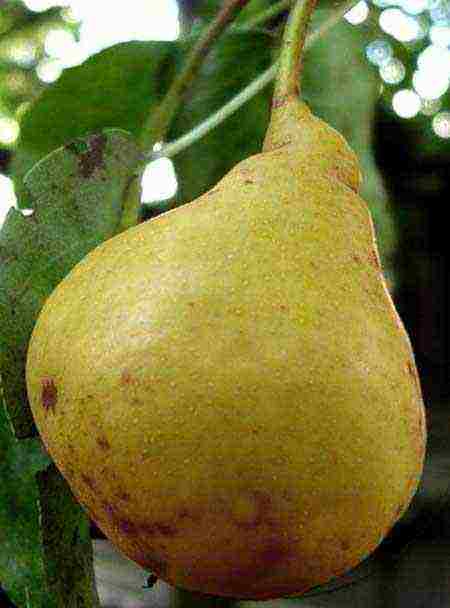
Dessert variety with an average yield and high winter hardiness, it is resistant to scab. Weakly ribbed, elongated-conical fruits weighing up to 110 g are covered with a yellow skin with a slightly reddish integumentary color, on which small brown subcutaneous dots are clearly visible. Very juicy, dense, semi-oily pulp has a delicate aroma and dessert taste. In terms of juiciness and softness, the fruits are unmatched, but in hot, dry weather, the quality of the fruits deteriorates.
Veles

Disease resistant winter-hardy variety with high yields (from 50 to 100 kg per well-groomed adult tree), frost-resistant ovaries. Fruits weighing 120-150 g with a wide funnel and a small, smooth, wide saucer are covered with a yellowish-green skin with a slight orange tan and subcutaneous dots. Delicious creamy pulp is very tender, juicy, semi-oily.
Faithful
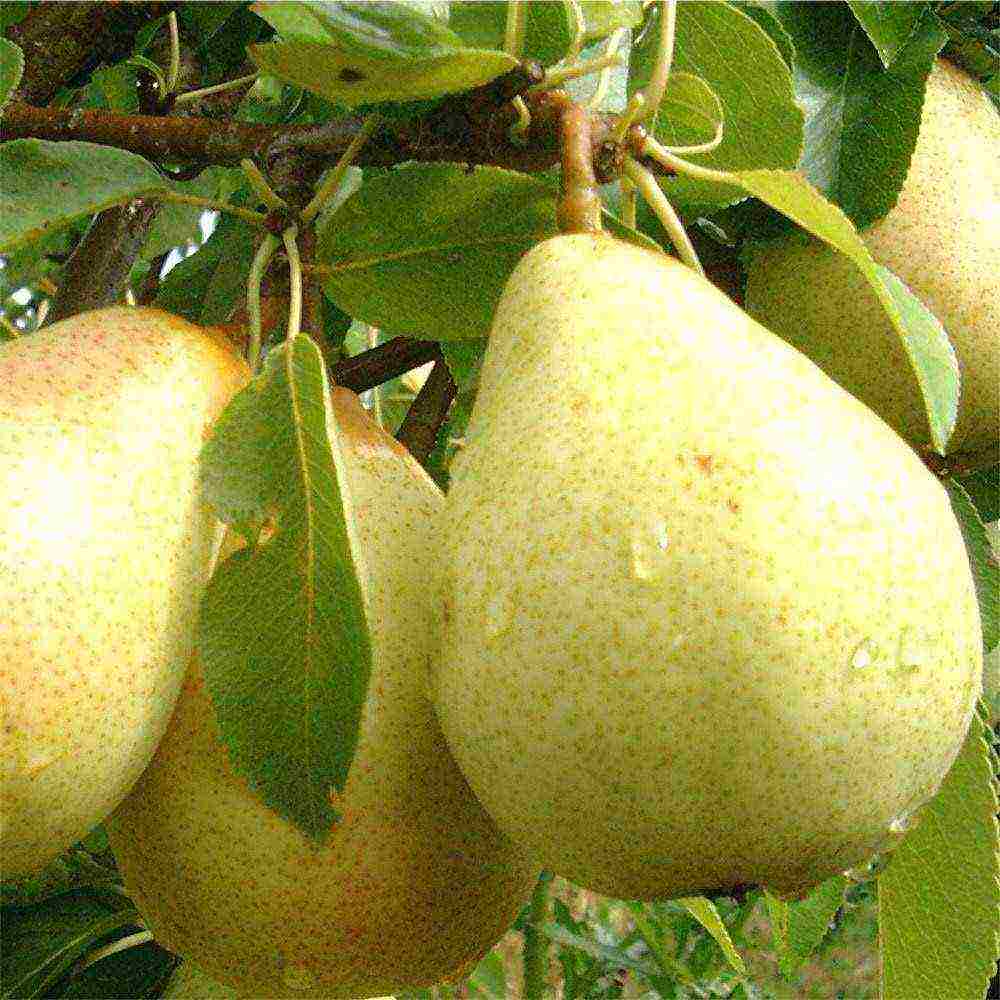
A high-yielding (about 100 kg per adult tree) late autumn variety with high winter hardiness (the ovaries can withstand frosts down to -2 ° C). Symmetrical, without a funnel, fruits with a lightly tanned yellowish skin and a short peduncle weigh from 90 to 130 g. The pulp is juicy, creamy, semi-oily, tasty.
Yeseninskaya
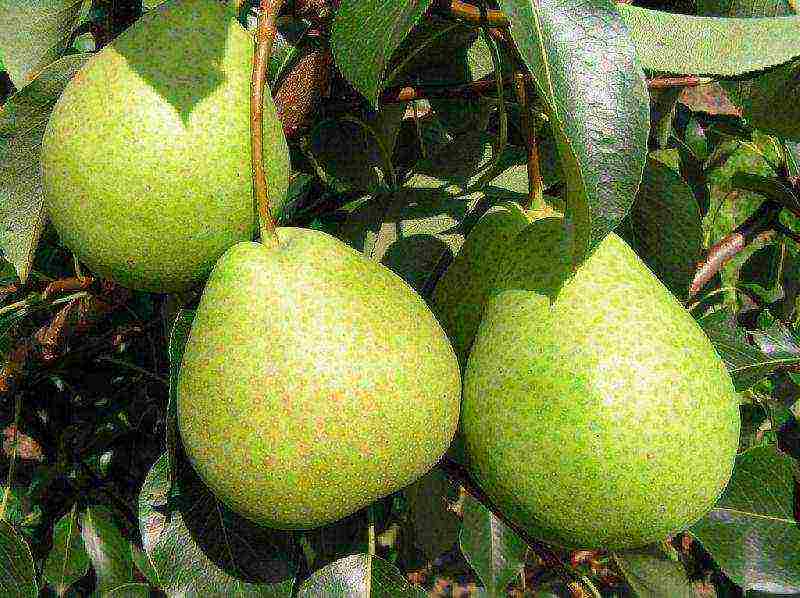
An early autumn high-yielding universal variety (50 kg per tree), scab resistant. Smooth fruits weighing about 140 g with a very shallow funnel and a wide shallow saucer are covered with a yellowish skin with an orange blush and clearly visible red subcutaneous dots. Semi-oily creamy pulp of medium density, sweet and sour taste, with a light nutmeg aroma. Differs in high taste of fruits.
Beauty Chernenko
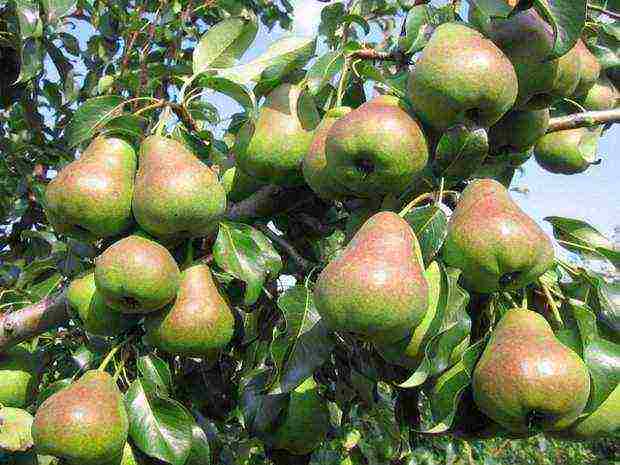
Table variety with high yield (80-85 kg per tree) and medium winter hardiness. It is resistant to scab. A tree with a rare narrow-pyramidal crown. Large fruits on a long, thick stalk weighing up to 200 g of golden yellow color are covered with a red blush. The saucer is wide, shallow, the funnel is shallow. Juicy tasty pulp melts in your mouth.
Muscovite
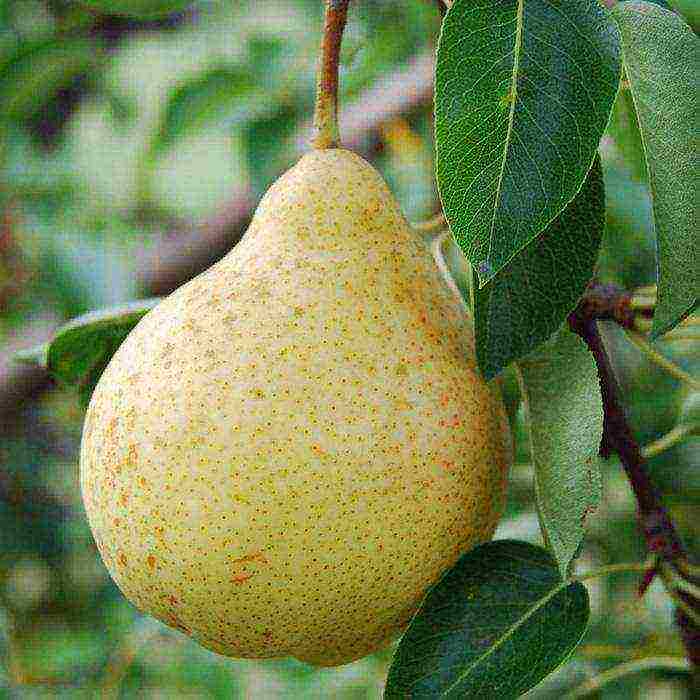
A fast-growing, versatile variety with a high (35-40 kg per tree) yield, resistant to fruit rot and scab. Possesses average winter hardiness. It does not suffer from spring frosts due to late flowering. The tree has a dense conical crown. Fruits even in size with a greenish-yellow color with integumentary points and a slight blush, without a funnel, with a wide saucer. Dense, white, semi-oily, very juicy pulp with a strong aroma and excellent taste. Differs in amicable ripening of fruits.
Muratovskaya
Yielding (60-70 kg per tree) table winter-hardy variety, resistant to scab. The green-yellow, blush-coated fruits on a thick, short stalk have a juicy, dense, semi-oily pulp with a sweet and sour taste and faint aroma. The saucer is narrow, there is no funnel.
Elegant Efimova

A table variety with medium winter hardiness and scab resistance. Productivity - 40 kg per adult tree. The tree has a pyramidal crown of medium density. Yellow-green, unusually beautiful, covered with a bright red blush, fruits weighing about 120 g without a funnel, with a shallow saucer on a long stalk with an influx. Slightly tart, tender, juicy, creamy pulp, very pleasant to the taste.
Otradnenskaya
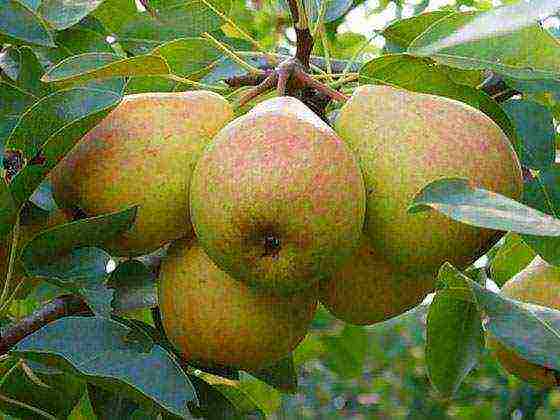
A fast-growing universal variety, medium-yielding (30-40 kg of fruits per tree), winter-hardy. Medium-sized tree with a round-pyramidal, dense crown. Yellowish-green, with a bright blush, fruits weighing about 100 g with a narrow funnel and saucer and a long thin stalk. The pulp is juicy, dense, sweet and sour taste.
Memory of Zhegalov
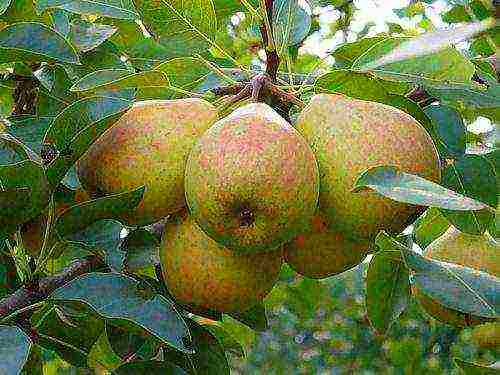
A versatile, early-growing, winter-hardy variety with an average yield (40 kg per tree), scab resistant. The crown is medium-dense, broadly pyramidal. The greenish-yellow fruits with rusty subcutaneous punctures weigh about 120 g. The saucer is ribbed, wide, the funnel is narrow. Semi-oily, dense, juicy pulp, aromatic, with a sweet and sour taste.
Potapovskaya

A winter-hardy universal variety with a dense pyramidal crown, scab resistant. Fruit weight about 140 g, yellow skin with red blush. The saucer is small, there is no funnel, the stalk is medium in length and thickness. The pulp is slightly tart, juicy, dense, sweet and sour. Productivity - 55 kg per season from an adult tree.
Fabulous

Not fast-growing, drought-resistant, versatile winter-hardy variety, resistant to scab and mites. Productivity - about 10 kg of fruit from one tree. A medium-sized tree with a compact, narrow-pyramidal, slightly spreading crown is heavily overgrown with shoots. The yellow-green fruits with a slight blush are covered with many subcutaneous dots. Medium-dense, fine-grained, tender, juicy white pulp with a very pleasant sweet and sour taste with spicy notes. The fruits are highly preserved, they tolerate transportation well.
Chizhovskaya
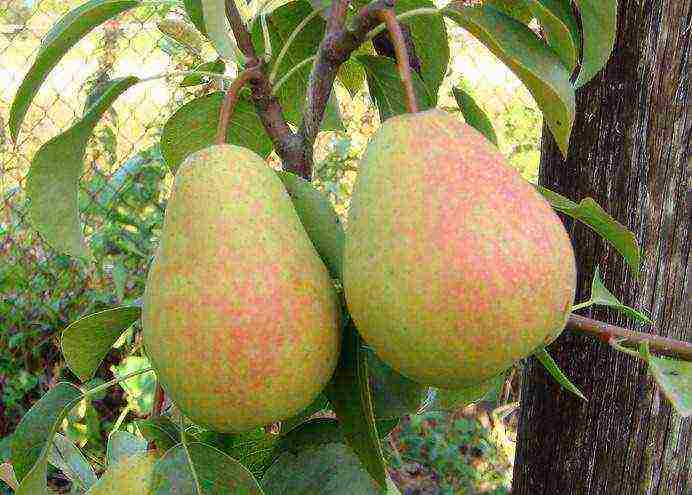
A universal, early-growing (in the 3rd year after planting the seedling begins to bear fruit) variety with an annual yield of up to 50 kg per tree, high winter hardiness, scab resistant. The oval crown is of medium density. Fruits with a yellow-green color, faint blush and subcutaneous punctures weigh about 120 g. The saucer is small, the funnel is narrow, the stalk is short. The pulp is semi-oily, juicy, dense, with a pleasant sweet and sour taste.
Winter (late) varieties
Fruits of late varieties cannot be brought into a warm room immediately after harvesting: they will harden or quickly begin to deteriorate.
Belarusian late
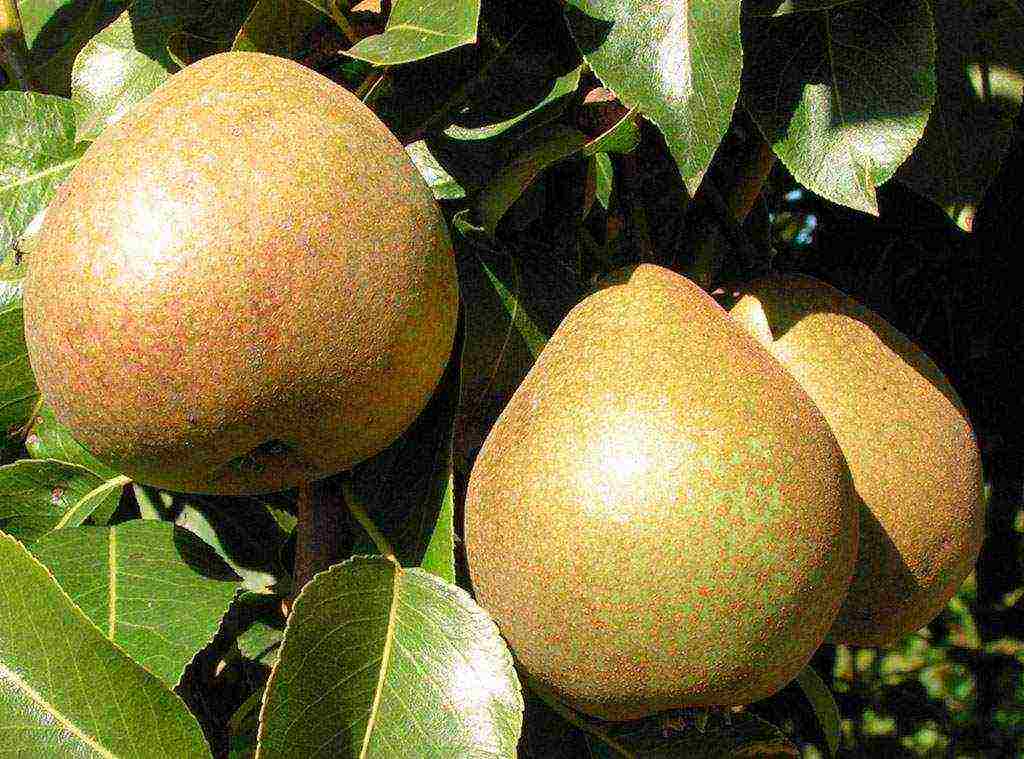
Lying, versatile, fast-growing, high-yielding variety (55-60 kg per tree) with increased winter hardiness. It is resistant to bacterial diseases, but it is affected by scab. A medium-sized tree has a dense crown. Fruits weighing 110-120 g are covered with a thick yellowish skin with rusty subcutaneous punctures, sometimes with a slight blush. Juicy, medium density, yellowish flesh with medium aroma and good taste. It can be stored in the basement until spring (longer than all varieties) (temperature from -1 ° C to 3 ° C, humidity about 80%).
Age-old

It is frost-resistant, not susceptible to fungal diseases. The tree gives its first harvest 5-6 years after planting. Fruit is harvested at the turn of September and October. Juicy and tasty fruits weighing 130-180 g with a light sourness palpable on the taste are stored for a month. The yield of one tree per season can reach 150 kg.
Festive
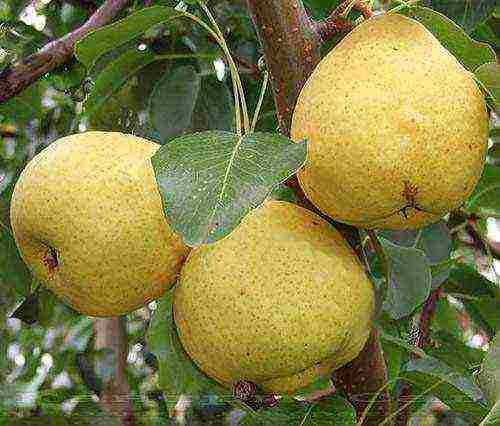
Pest-resistant winter variety with high yields (30-35 kg per tree) and pyramidal crown. Small (up to 100 g) fruits with firm juicy pulp, sweet and sour taste and aroma of tropical fruits have an average keeping quality.
Miracle woman
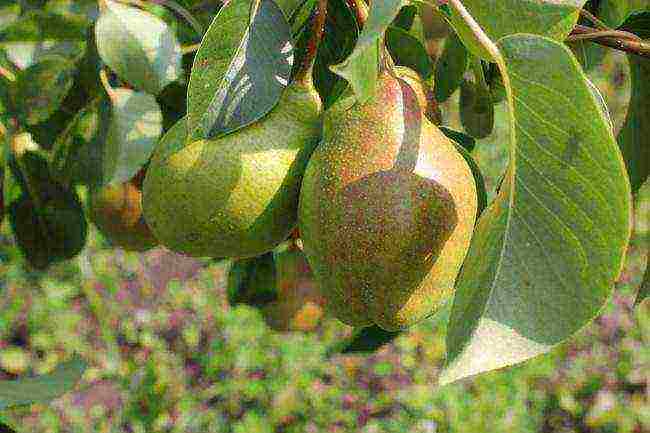
A winter-hardy variety, with high-quality insulation, withstands frosts down to -50 ° C, with a consistently high annual yield. Large (200-220 g) fruits with a pronounced aroma, sweet taste and sourish aftertaste tend to fall off as they ripen.
January
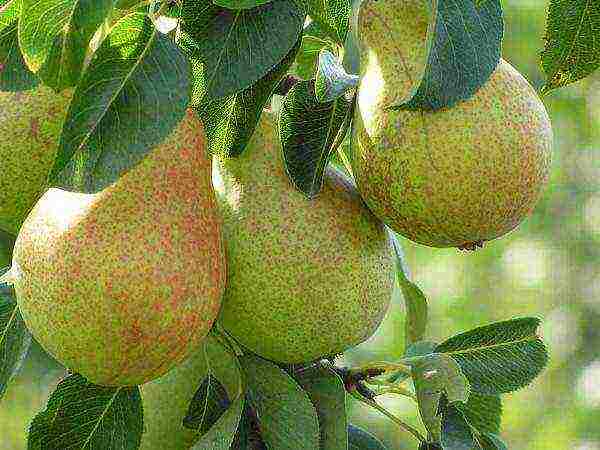
Dessert, fruitful, stable, self-fertile variety, scab resistant. Drought resistance and winter hardiness are average. Medium-sized tree with a rounded crown of medium density. Golden-yellow fruits without a funnel, with a medium-sized saucer, weighing 120-200 g with small subcutaneous punctures. Oily, white, medium-dense pulp with excellent taste and low aroma.
The sweetest varieties
Most ripe pears have a sweet taste, but there are varieties that will be just as sweet, even unripe.
Prominent
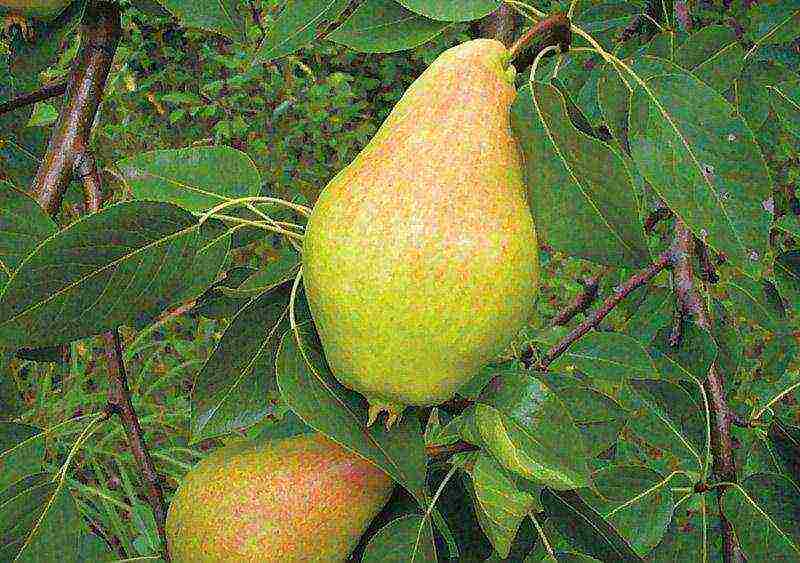
The variety is fruitful, fast-growing, versatile, winter-hardy, scab resistant. The ovaries are characterized by high frost resistance. The tree is vigorous, the crown is narrow-pyramidal. Fruits, greenish-yellow with a slight tan, weighing about 150 g, have a wide saucer, a narrow and shallow funnel, and a thick short stalk. Semi-oily, juicy, tender white pulp with a good sweet taste.
The fruit is not stored even for several days, it is recommended to preserve it or immediately use it fresh.
Buttery sweet
A versatile variety in use, suitable for long-term storage, unpretentious in care, resistant to diseases. Pears with a high concentration of sugar are not only consumed fresh, but they are also made into liqueurs, wine, and canned goods.
Autumn sweet
In terms of juiciness and richness of taste, it is not inferior to southern varieties, resistant to pests and insects, tolerates long-term frosts well. Fragrant fruits of bright yellow color with elastic, juicy pulp are stored for no more than a month.
The pear occupies an outside position in comparison with the apple tree - the undisputed leader among domestic fruit plants. It's all about a certain capriciousness of a pear, difficulties in pruning, an abundance of diseases, difficulties with storing fruits. Despite this, they love the pear, the pear is grown and the pear is eaten with pleasure, sometimes doused with juice flowing from the fruit. Well, what the taste of grandmother's pear jam tastes like, everyone knows and remembers, probably. Let's talk today about 15 of the most interesting pear varieties, giving preference to new ones. For convenience, we will divide the description of pear varieties into three categories: first, we will describe the early ripening varieties, then the middle ones and, finally, the late ones, which become tastier some time after harvesting.
Pears of different varieties
Content:
- Early varieties of pears for the middle lane
- Medium ripening pear varieties
- Late varieties of pear
Early varieties of pears for the middle lane
1. Pear "Prominent"
Typical summer cultivar, a medium-sized tree with a narrow pyramid-shaped crown with curved, brown, bare and rounded shoots. Leaf blades are green in color, rather oblong, with a smooth surface. Pears reach a mass of 120 grams, have a slightly elongated pear-shaped shape, with tubercles on the surface. A very short stalk, set obliquely, and a small funnel are noted.
The fruits are greenish-yellow and have a slight pinkish tan on the south side of the fruit. If you take a closer look at the fetus, you will notice grayish subcutaneous dots. The pear's pulp is snow-white, very tender, with an abundance of juice. Tasters rate the palatability 4.4 points out of a maximum of five points. Of the positive qualities of the variety, it should be noted its high winter hardiness for central Russia and the yield, reaching 100 centners per hectare in some regions.
2. Pear "Bryansk beauty"
Typical late summer variety, which is a medium-sized tree, weakly growing, with a crown in the form of a sparse ball with compact, brownish-brown color, geniculate, naked and rounded in shape shoots, the ends of which are directed upwards. The leaf blades are dark green in color, rather elongated, with a smooth, shiny surface.
Pears reach a mass of 205 grams, have a slightly elongated pear-shaped shape. The fruits are golden yellow in color and have a slight pinkish tan on the south side of the fruit. If you take a closer look at the fetus, you will notice grayish subcutaneous dots, the number of which is small. The pulp of the pear is creamy, very tender, moderately dense, with an abundance of juice. Tasters rate the palatability at 4.8 points out of the maximum five points, possibly also due to the pleasant pear aroma. Of the positive qualities of the variety, its early maturity should be noted - the fruits will have to wait only five years from the seedlings.
Pear Bryansk beauty
3. Pear "The same age"
Typical late summer variety, which is a medium-sized tree with a crown in the form of a round compact pyramid of medium density. Pears reach a mass of 85 grams, are mostly pear-shaped, with a gloss on the surface. The fruits are golden yellow in color with a slight orange blush on the south side of the fruit.
The pulp of the pear is creamy, tender, medium in density, with an abundance of juice.Tasters rate the palatability 4.5 points out of a maximum of five points. Fruits become tastier after a little "lying" (within a week).
4. Pear "Banana"
Typical summer variety, which is a medium-sized tree with a drooping, medium-thickened crown and curved, brown, bare and rounded shoots. Leaf blades are green in color, rather oblong, with a smooth surface. Pears reach a mass of 80 grams, are pear-shaped, with a smooth surface. A very long and curved peduncle was noted, there is no funnel, as well as no rustiness. The fruits are greenish and have a slight brownish-red tan on the southern side of the fruit. If you take a closer look at the fetus, you will notice greenish subcutaneous dots.
The pear's pulp is creamy, tender, with an abundance of juice. Tasters rate the palatability at 4.6 points out of the maximum five points (although gardeners note the fruit's fresh-sweet taste, but with a pleasant aroma). Of the positive qualities of the variety, it should be noted its high winter hardiness for central Russia and the yield, reaching 300 centners per hectare in some regions.
5. Pear "Skorospelka from Michurinsk"
Typical early summer variety, which is a medium-sized tree with a crown in the form of a rounded pyramid of medium thickening. Pears reach a mass of 70 grams, have a rounded pear-shaped shape. The fruits are yellow-green in color and have a slight pinkish tan on the southern side of the fruit.
The pear's pulp is creamy, tender, with an abundance of juice. Tasters rate the taste at 4.7 points out of the maximum five points (according to the reviews of amateur gardeners, the taste is sweet and sour, with a pleasant pear aroma). Of the positive qualities of the variety, it should be noted its relative resistance to scab and yield, reaching 200 centners per hectare in some regions.
Pear Skorospelka from Michurinsk
6. Pear "Veles"
Typical autumn cultivar, which is a medium-sized tree with a drooping pyramid-shaped crown with arched, cherry-brown, bare and rounded shoots. Leaf blades are yellow-green in color, elongated-oval, with a smooth surface and curved edges. Pears reach a mass of 120 grams, have a pear-shaped shape, only a slightly beveled and curved stalk. A blunt-conical funnel and a shallow saucer are noted.
The fruits are yellow-green in color and have a slight orange tan on the south side of the fruit. If you take a closer look at the fetus, you will notice grayish subcutaneous dots. The pulp of the pear is creamy, very tender, with an abundance of juice, slightly oily. The tasters rate the palatability at 4.6 points out of a maximum of five points. Of the positive qualities of the variety, it should be noted its high winter hardiness for central Russia, resistance to return frosts up to -20C and yield, reaching 130 centners per hectare in some regions.
7. Pear "Thumbelina"
Typical autumn cultivar, which is a medium-sized tree with a rounded crown and brownish-brown color, bare and rounded shoots. Leaf blades are green in color, elliptical in shape. Pears reach a weight of 70 grams, have a slightly elongated pear-shaped shape. A very long and slender peduncle was noted, set up straight, there is no funnel. The fruits are golden yellow in color and have a slight tan on the south side of the fruit.
The pulp of the pear is creamy, tender, with an abundance of juice, slightly oily. Tasters rate the palatability 4.8 out of a maximum of five points. Of the positive qualities of the variety, it should be noted its high winter hardiness for central Russia and the yield, reaching 70 centners per hectare in some regions.
8. Pear "Just Maria"
Typical autumn variety, which is a medium-sized tree, actively growing, with a crown of medium density, in the form of a wide pyramid. Leaf blades are medium in size, rather oblong, short-pointed. Pears reach a mass of 180 grams and are pear-shaped. A shallow and blunt-conical funnel was noted. Fruits at the moment of ripening are colored light yellow, have a slight pinkish tan on the southern side of the fruit. After a week of storage, the fruits turn light yellow with a pinkish tan on a third of the fruit.
The pulp of the pear is yellowish-white, medium in density, tender, with an abundance of juice, buttery and fine-grained. Tasters rate the palatability at 4.8 points out of a maximum of five points (gardeners refer to the taste as sour-sweet with a low aroma). Of the positive qualities of the variety, its yield should be noted, reaching 80 centners per hectare in some regions.
Pear Just Maria
9. Pear "Irista"
Typical early autumn cultivar, which is a medium-sized tree, characterized by medium growth, with a sparse crown in the form of an inverted pyramid. The leaf blades are medium in size, rather oblong, ovoid. Pears reach a mass of 155 grams, have a wide pear-shaped, regular shape. There is no funnel. Fruits in the period of removable maturity are greenish in color, have a slight pinkish tan on the southern side of the fruit. After a week of storage, the fruits acquire a greenish-yellow color and a pinkish tan on 60% of the fruit surface.
The pear pulp is snow-white, medium in density, but rather tender, with an abundance of juice and semi-oily. Tasters rate the taste at 4.5 points out of a maximum of five points (amateur gardeners characterize the taste as sweet and sour with a pleasant aroma). Of the positive qualities of the variety, it should be noted its high yield, reaching 180 centners per hectare in some regions.
10. Pear "Yeseninskaya"
Typical early autumn variety, which is a medium-sized tree with medium vigor, with a dense crown in the form of a pyramid with shoots sharply extending from the trunk. The leaf blades are medium in size, elliptical in shape, with a long taper and concavity. Pears reach a mass of 145 grams, are pear-shaped, with a smooth surface. A shallow, blunt-conical funnel was noted. During the period of removable ripeness, the fruits are colored light green, have a slight tan on the southern side of the fruit. After a week of storage, the fruits acquire a greenish-yellow color with an orange and pinkish-scarlet integumentary, very large, vague dots.
The pulp of the pear is creamy, medium in density, tender, with an abundance of juice and fine-grained. Tasters rate the taste at 4.3 points out of the maximum five points (amateur gardeners characterize the taste as sweet and sour with a pleasant pear aroma). Of the positive qualities of the variety, it should be noted its high yield, reaching 130 centners per hectare in some regions.
11. Pear "Belarusian late"
Typical winter cultivar, which is a medium-sized tree with medium vigor, with a spherical and very dense crown. The leaf blades are light green in color, rather oblong, elliptical in shape with a long pointed. Pears reach a mass of 120 grams, have a wide pear-shaped shape. The fruits are orange-yellow in color, have a slight crimson blurred tan on the southern side of the fruit.
The pulp of the pear is snow-white, medium in density, but tender, with an abundance of juice, buttery. Tasters rate the taste at 4.2 points out of the maximum five points (amateur gardeners characterize the taste as sweet and sour with a refreshing sourness). Of the positive qualities of the variety, it should be noted its high yield, reaching 130 centners per hectare in some regions.
Pear Belarusian late
12. Pear "Yuryevskaya"
Typical early winter variety, which is a vigorous tree with a pyramid-shaped crown with straight, reddish-brown, rounded shoots. Leaf blades are green, elliptical, short-pointed. Pears reach a weight of 130 grams, have a short pear-shaped shape. A very thick peduncle is noted, which is slightly curved, and a weak funnel. The fruits are greenish-yellow in color, have a slight brown, blurred tan on the southern side of the fruit.
The pear's pulp is greenish-creamy, rather dense, tender, with an abundance of juice. Tasters rate the palatability 4.5 points out of the maximum five points (amateur gardeners characterize the taste as sweet and sour with a pleasant pear aroma). Fruits are usually harvested in late September - early October, and it is better to eat them in mid-October, they usually lie before the New Year. Of the positive qualities of the variety, it should be noted its high yield, reaching 127 centners per hectare in some regions.
13. Pear "Novella"
Typical winter, table variety, which is a medium-sized tree with a crown in the form of a narrow pyramid with thick, straight, geniculate, yellow, bare shoots. Leaf blades are green in color, ovoid, with a smooth and shiny surface. Pears reach a mass of 135 grams, have a short pear-shaped shape. A blunt-conical funnel is noted. The fruits are greenish in color, have a slight pinkish blurred tan on the southern side of the fruit. If you take a closer look at the fetus, you can see the subcutaneous dots of medium size.
The pulp of the pear is creamy, has granules, medium in density, with an abundance of juice. Tasters rate the taste at 4.3 points out of a maximum of five points (amateur gardeners characterize the taste as sour-sweet with a medium pear aroma). Of the positive qualities of the variety, it should be noted its high yield, reaching 150 centners per hectare in some regions.
14. Pear "Otradnenskaya"
Typical late autumn variety, which is a medium-sized tree with a spreading crown, straight, geniculate shoots. The leaf blades are dark green in color, broadly ovate, with a smooth surface. Pears reach a mass of 99 grams, have an oblong-rounded regular shape. A very shallow funnel was noted. The fruits are greenish-yellow and have a slight tan on the south side of the fruit.
The pear's pulp is whitish-creamy, tender, with an abundance of juice. Tasters rate the palatability at 4.3 points out of a maximum of five points. Of the positive qualities of the variety, it should be noted its high yield, reaching 200 centners per hectare and even more in some regions.
15. Pear "Extravaganza"
Typical winter variety, which is a medium-sized tree with a crown in the form of a wide pyramid with medium-sized arcuate, brownish-brown shoots, devoid of pubescence. Leaf blades are green in color, ovoid, with a smooth surface. Pears reach a weight of 130 grams, have an elongated pear-shaped shape. The absence of a funnel and saucer was noted. The fruits are greenish-yellow in color, have a slight crimson, washed-out tan on the southern side of the fruit. If you take a closer look at the fetus, you can see the subcutaneous dots of medium size.
Pear pulp is snow-white, semi-oily. Tasters rate the palatability 4.4 points out of a maximum of five points. Of the positive qualities of the variety, it should be noted its high yield, reaching 150 centners per hectare in some regions.
We have described the most interesting and common pear varieties (at least judging by their presence in nurseries). In the comments, please write your favorite pear varieties and be sure to indicate in which region you live. Our readers will be very grateful to you!
